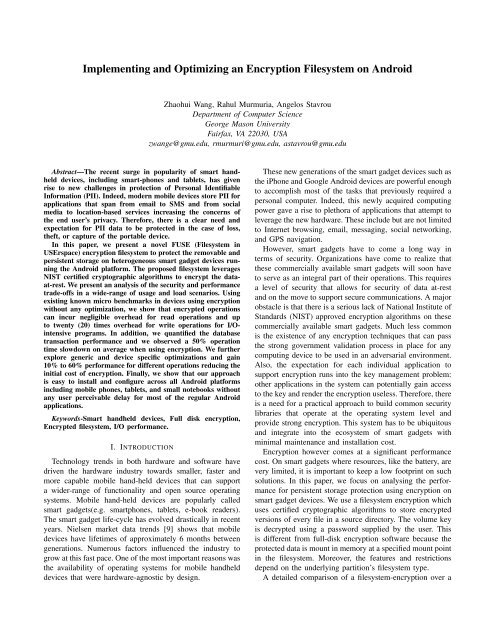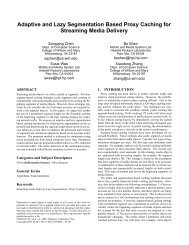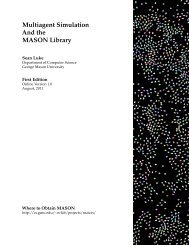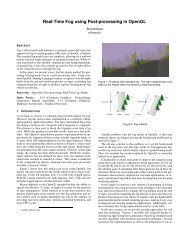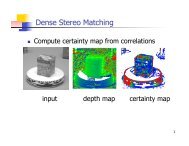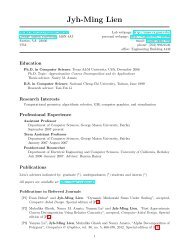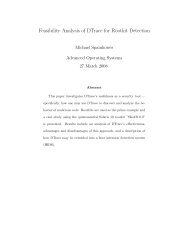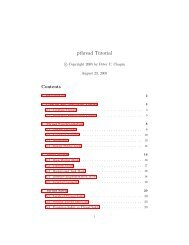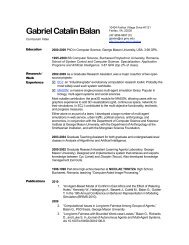Implementing and Optimizing an Encryption Filesystem on Android
Implementing and Optimizing an Encryption Filesystem on Android
Implementing and Optimizing an Encryption Filesystem on Android
You also want an ePaper? Increase the reach of your titles
YUMPU automatically turns print PDFs into web optimized ePapers that Google loves.
<str<strong>on</strong>g>Implementing</str<strong>on</strong>g> <str<strong>on</strong>g><str<strong>on</strong>g>an</str<strong>on</strong>g>d</str<strong>on</strong>g> <str<strong>on</strong>g>Optimizing</str<strong>on</strong>g> <str<strong>on</strong>g>an</str<strong>on</strong>g> <str<strong>on</strong>g>Encrypti<strong>on</strong></str<strong>on</strong>g> <str<strong>on</strong>g>Filesystem</str<strong>on</strong>g> <strong>on</strong> <strong>Android</strong><br />
Abstract—The recent surge in popularity of smart h<str<strong>on</strong>g><str<strong>on</strong>g>an</str<strong>on</strong>g>d</str<strong>on</strong>g>held<br />
devices, including smart-ph<strong>on</strong>es <str<strong>on</strong>g><str<strong>on</strong>g>an</str<strong>on</strong>g>d</str<strong>on</strong>g> tablets, has given<br />
rise to new challenges in protecti<strong>on</strong> of Pers<strong>on</strong>al Identifiable<br />
Informati<strong>on</strong> (PII). Indeed, modern mobile devices store PII for<br />
applicati<strong>on</strong>s that sp<str<strong>on</strong>g>an</str<strong>on</strong>g> from email to SMS <str<strong>on</strong>g><str<strong>on</strong>g>an</str<strong>on</strong>g>d</str<strong>on</strong>g> from social<br />
media to locati<strong>on</strong>-based services increasing the c<strong>on</strong>cerns of<br />
the end user’s privacy. Therefore, there is a clear need <str<strong>on</strong>g><str<strong>on</strong>g>an</str<strong>on</strong>g>d</str<strong>on</strong>g><br />
expectati<strong>on</strong> for PII data to be protected in the case of loss,<br />
theft, or capture of the portable device.<br />
In this paper, we present a novel FUSE (<str<strong>on</strong>g>Filesystem</str<strong>on</strong>g> in<br />
USErspace) encrypti<strong>on</strong> filesystem to protect the removable <str<strong>on</strong>g><str<strong>on</strong>g>an</str<strong>on</strong>g>d</str<strong>on</strong>g><br />
persistent storage <strong>on</strong> heterogeneous smart gadget devices running<br />
the <strong>Android</strong> platform. The proposed filesystem leverages<br />
NIST certified cryptographic algorithms to encrypt the dataat-rest.<br />
We present <str<strong>on</strong>g>an</str<strong>on</strong>g> <str<strong>on</strong>g>an</str<strong>on</strong>g>alysis of the security <str<strong>on</strong>g><str<strong>on</strong>g>an</str<strong>on</strong>g>d</str<strong>on</strong>g> perform<str<strong>on</strong>g>an</str<strong>on</strong>g>ce<br />
trade-offs in a wide-r<str<strong>on</strong>g>an</str<strong>on</strong>g>ge of usage <str<strong>on</strong>g><str<strong>on</strong>g>an</str<strong>on</strong>g>d</str<strong>on</strong>g> load scenarios. Using<br />
existing known micro benchmarks in devices using encrypti<strong>on</strong><br />
without <str<strong>on</strong>g>an</str<strong>on</strong>g>y optimizati<strong>on</strong>, we show that encrypted operati<strong>on</strong>s<br />
c<str<strong>on</strong>g>an</str<strong>on</strong>g> incur negligible overhead for read operati<strong>on</strong>s <str<strong>on</strong>g><str<strong>on</strong>g>an</str<strong>on</strong>g>d</str<strong>on</strong>g> up<br />
to twenty (20) times overhead for write operati<strong>on</strong>s for I/Ointensive<br />
programs. In additi<strong>on</strong>, we qu<str<strong>on</strong>g>an</str<strong>on</strong>g>tified the database<br />
tr<str<strong>on</strong>g>an</str<strong>on</strong>g>sacti<strong>on</strong> perform<str<strong>on</strong>g>an</str<strong>on</strong>g>ce <str<strong>on</strong>g><str<strong>on</strong>g>an</str<strong>on</strong>g>d</str<strong>on</strong>g> we observed a 50% operati<strong>on</strong><br />
time slowdown <strong>on</strong> average when using encrypti<strong>on</strong>. We further<br />
explore generic <str<strong>on</strong>g><str<strong>on</strong>g>an</str<strong>on</strong>g>d</str<strong>on</strong>g> device specific optimizati<strong>on</strong>s <str<strong>on</strong>g><str<strong>on</strong>g>an</str<strong>on</strong>g>d</str<strong>on</strong>g> gain<br />
10% to 60% perform<str<strong>on</strong>g>an</str<strong>on</strong>g>ce for different operati<strong>on</strong>s reducing the<br />
initial cost of encrypti<strong>on</strong>. Finally, we show that our approach<br />
is easy to install <str<strong>on</strong>g><str<strong>on</strong>g>an</str<strong>on</strong>g>d</str<strong>on</strong>g> c<strong>on</strong>figure across all <strong>Android</strong> platforms<br />
including mobile ph<strong>on</strong>es, tablets, <str<strong>on</strong>g><str<strong>on</strong>g>an</str<strong>on</strong>g>d</str<strong>on</strong>g> small notebooks without<br />
<str<strong>on</strong>g>an</str<strong>on</strong>g>y user perceivable delay for most of the regular <strong>Android</strong><br />
applicati<strong>on</strong>s.<br />
Keywords-Smart h<str<strong>on</strong>g><str<strong>on</strong>g>an</str<strong>on</strong>g>d</str<strong>on</strong>g>held devices, Full disk encrypti<strong>on</strong>,<br />
Encrypted filesystem, I/O perform<str<strong>on</strong>g>an</str<strong>on</strong>g>ce.<br />
I. INTRODUCTION<br />
Technology trends in both hardware <str<strong>on</strong>g><str<strong>on</strong>g>an</str<strong>on</strong>g>d</str<strong>on</strong>g> software have<br />
driven the hardware industry towards smaller, faster <str<strong>on</strong>g><str<strong>on</strong>g>an</str<strong>on</strong>g>d</str<strong>on</strong>g><br />
more capable mobile h<str<strong>on</strong>g><str<strong>on</strong>g>an</str<strong>on</strong>g>d</str<strong>on</strong>g>-held devices that c<str<strong>on</strong>g>an</str<strong>on</strong>g> support<br />
a wider-r<str<strong>on</strong>g>an</str<strong>on</strong>g>ge of functi<strong>on</strong>ality <str<strong>on</strong>g><str<strong>on</strong>g>an</str<strong>on</strong>g>d</str<strong>on</strong>g> open source operating<br />
systems. Mobile h<str<strong>on</strong>g><str<strong>on</strong>g>an</str<strong>on</strong>g>d</str<strong>on</strong>g>-held devices are popularly called<br />
smart gadgets(e.g. smartph<strong>on</strong>es, tablets, e-book readers).<br />
The smart gadget life-cycle has evolved drastically in recent<br />
years. Nielsen market data trends [9] shows that mobile<br />
devices have lifetimes of approximately 6 m<strong>on</strong>ths between<br />
generati<strong>on</strong>s. Numerous factors influenced the industry to<br />
grow at this fast pace. One of the most import<str<strong>on</strong>g>an</str<strong>on</strong>g>t reas<strong>on</strong>s was<br />
the availability of operating systems for mobile h<str<strong>on</strong>g><str<strong>on</strong>g>an</str<strong>on</strong>g>d</str<strong>on</strong>g>held<br />
devices that were hardware-agnostic by design.<br />
Zhaohui W<str<strong>on</strong>g>an</str<strong>on</strong>g>g, Rahul Murmuria, Angelos Stavrou<br />
Department of Computer Science<br />
George Mas<strong>on</strong> University<br />
Fairfax, VA 22030, USA<br />
zw<str<strong>on</strong>g>an</str<strong>on</strong>g>ge@gmu.edu, rmurmuri@gmu.edu, astavrou@gmu.edu<br />
These new generati<strong>on</strong>s of the smart gadget devices such as<br />
the iPh<strong>on</strong>e <str<strong>on</strong>g><str<strong>on</strong>g>an</str<strong>on</strong>g>d</str<strong>on</strong>g> Google <strong>Android</strong> devices are powerful enough<br />
to accomplish most of the tasks that previously required a<br />
pers<strong>on</strong>al computer. Indeed, this newly acquired computing<br />
power gave a rise to plethora of applicati<strong>on</strong>s that attempt to<br />
leverage the new hardware. These include but are not limited<br />
to Internet browsing, email, messaging, social networking,<br />
<str<strong>on</strong>g><str<strong>on</strong>g>an</str<strong>on</strong>g>d</str<strong>on</strong>g> GPS navigati<strong>on</strong>.<br />
However, smart gadgets have to come a l<strong>on</strong>g way in<br />
terms of security. Org<str<strong>on</strong>g>an</str<strong>on</strong>g>izati<strong>on</strong>s have come to realize that<br />
these commercially available smart gadgets will so<strong>on</strong> have<br />
to serve as <str<strong>on</strong>g>an</str<strong>on</strong>g> integral part of their operati<strong>on</strong>s. This requires<br />
a level of security that allows for security of data at-rest<br />
<str<strong>on</strong>g><str<strong>on</strong>g>an</str<strong>on</strong>g>d</str<strong>on</strong>g> <strong>on</strong> the move to support secure communicati<strong>on</strong>s. A major<br />
obstacle is that there is a serious lack of Nati<strong>on</strong>al Institute of<br />
St<str<strong>on</strong>g><str<strong>on</strong>g>an</str<strong>on</strong>g>d</str<strong>on</strong>g>ards (NIST) approved encrypti<strong>on</strong> algorithms <strong>on</strong> these<br />
commercially available smart gadgets. Much less comm<strong>on</strong><br />
is the existence of <str<strong>on</strong>g>an</str<strong>on</strong>g>y encrypti<strong>on</strong> techniques that c<str<strong>on</strong>g>an</str<strong>on</strong>g> pass<br />
the str<strong>on</strong>g government validati<strong>on</strong> process in place for <str<strong>on</strong>g>an</str<strong>on</strong>g>y<br />
computing device to be used in <str<strong>on</strong>g>an</str<strong>on</strong>g> adversarial envir<strong>on</strong>ment.<br />
Also, the expectati<strong>on</strong> for each individual applicati<strong>on</strong> to<br />
support encrypti<strong>on</strong> runs into the key m<str<strong>on</strong>g>an</str<strong>on</strong>g>agement problem:<br />
other applicati<strong>on</strong>s in the system c<str<strong>on</strong>g>an</str<strong>on</strong>g> potentially gain access<br />
to the key <str<strong>on</strong>g><str<strong>on</strong>g>an</str<strong>on</strong>g>d</str<strong>on</strong>g> render the encrypti<strong>on</strong> useless. Therefore, there<br />
is a need for a practical approach to build comm<strong>on</strong> security<br />
libraries that operate at the operating system level <str<strong>on</strong>g><str<strong>on</strong>g>an</str<strong>on</strong>g>d</str<strong>on</strong>g><br />
provide str<strong>on</strong>g encrypti<strong>on</strong>. This system has to be ubiquitous<br />
<str<strong>on</strong>g><str<strong>on</strong>g>an</str<strong>on</strong>g>d</str<strong>on</strong>g> integrate into the ecosystem of smart gadgets with<br />
minimal mainten<str<strong>on</strong>g>an</str<strong>on</strong>g>ce <str<strong>on</strong>g><str<strong>on</strong>g>an</str<strong>on</strong>g>d</str<strong>on</strong>g> installati<strong>on</strong> cost.<br />
<str<strong>on</strong>g>Encrypti<strong>on</strong></str<strong>on</strong>g> however comes at a signific<str<strong>on</strong>g>an</str<strong>on</strong>g>t perform<str<strong>on</strong>g>an</str<strong>on</strong>g>ce<br />
cost. On smart gadgets where resources, like the battery, are<br />
very limited, it is import<str<strong>on</strong>g>an</str<strong>on</strong>g>t to keep a low footprint <strong>on</strong> such<br />
soluti<strong>on</strong>s. In this paper, we focus <strong>on</strong> <str<strong>on</strong>g>an</str<strong>on</strong>g>alysing the perform<str<strong>on</strong>g>an</str<strong>on</strong>g>ce<br />
for persistent storage protecti<strong>on</strong> using encrypti<strong>on</strong> <strong>on</strong><br />
smart gadget devices. We use a filesystem encrypti<strong>on</strong> which<br />
uses certified cryptographic algorithms to store encrypted<br />
versi<strong>on</strong>s of every file in a source directory. The volume key<br />
is decrypted using a password supplied by the user. This<br />
is different from full-disk encrypti<strong>on</strong> software because the<br />
protected data is mount in memory at a specified mount point<br />
in the filesystem. Moreover, the features <str<strong>on</strong>g><str<strong>on</strong>g>an</str<strong>on</strong>g>d</str<strong>on</strong>g> restricti<strong>on</strong>s<br />
depend <strong>on</strong> the underlying partiti<strong>on</strong>’s filesystem type.<br />
A detailed comparis<strong>on</strong> of a filesystem-encrypti<strong>on</strong> over a
kernel-based full-disk encrypti<strong>on</strong> is bey<strong>on</strong>d the scope of this<br />
paper. However, we list some of the adv<str<strong>on</strong>g>an</str<strong>on</strong>g>tages that applied<br />
to us.<br />
• We were able to leverage NIST validated cryptographic<br />
libraries [6] which are not implemented in kernel-space.<br />
• Our implementati<strong>on</strong> c<str<strong>on</strong>g>an</str<strong>on</strong>g> be extended to different hardware<br />
with negligible effort.<br />
• We focus <strong>on</strong> data encrypti<strong>on</strong> without having to deal<br />
with other aspects of filesystem design. Underlying<br />
filesystems like ext3 <str<strong>on</strong>g><str<strong>on</strong>g>an</str<strong>on</strong>g>d</str<strong>on</strong>g> yaffs2 already have str<strong>on</strong>g<br />
support for h<str<strong>on</strong>g><str<strong>on</strong>g>an</str<strong>on</strong>g>d</str<strong>on</strong>g>ling data-corrupti<strong>on</strong> <str<strong>on</strong>g><str<strong>on</strong>g>an</str<strong>on</strong>g>d</str<strong>on</strong>g> journalling.<br />
Since file I/O operati<strong>on</strong>s <strong>on</strong> the mount point eventually hit<br />
the encrypted copy of the file <strong>on</strong> the underlying filesystem,<br />
various perform<str<strong>on</strong>g>an</str<strong>on</strong>g>ce optimizati<strong>on</strong>s c<str<strong>on</strong>g>an</str<strong>on</strong>g> be possible by adjusting<br />
the filesystem parameters such as block size, buffer size.<br />
In additi<strong>on</strong>, we <str<strong>on</strong>g>an</str<strong>on</strong>g>alyse the perform<str<strong>on</strong>g>an</str<strong>on</strong>g>ce of various SQLite<br />
database tr<str<strong>on</strong>g>an</str<strong>on</strong>g>sacti<strong>on</strong>s <strong>on</strong> <strong>Android</strong>.<br />
The main c<strong>on</strong>tributi<strong>on</strong>s of this paper are summarized as<br />
follows:<br />
• We are the first to study the filesystem encrypti<strong>on</strong>’s<br />
perform<str<strong>on</strong>g>an</str<strong>on</strong>g>ce <strong>on</strong> commodity smart gadget devices given<br />
modern NAND technology as storage media. To that<br />
end, we ported <str<strong>on</strong>g>an</str<strong>on</strong>g> open-source cryptographic filesystem,<br />
EncFS, <strong>on</strong> commodity <strong>Android</strong> systems<br />
• We present benchmark results of the EncFS running<br />
<strong>on</strong> <strong>Android</strong> system with various I/O operati<strong>on</strong>s. Particularly,<br />
we focus our <str<strong>on</strong>g>an</str<strong>on</strong>g>alysis <strong>on</strong> the security versus<br />
perform<str<strong>on</strong>g>an</str<strong>on</strong>g>ce trade-off including SQLite database tr<str<strong>on</strong>g>an</str<strong>on</strong>g>sacti<strong>on</strong>s<br />
• Finally, we discuss the limitati<strong>on</strong>s of filesystem encrypti<strong>on</strong><br />
<str<strong>on</strong>g><str<strong>on</strong>g>an</str<strong>on</strong>g>d</str<strong>on</strong>g> dem<strong>on</strong>strate that it is feasible <strong>on</strong> smart gadget<br />
devices with a reas<strong>on</strong>able perform<str<strong>on</strong>g>an</str<strong>on</strong>g>ce overhead.<br />
The rest of this paper is org<str<strong>on</strong>g>an</str<strong>on</strong>g>ized as follows: Secti<strong>on</strong><br />
II presents related research <strong>on</strong> mobile operating system<br />
<str<strong>on</strong>g><str<strong>on</strong>g>an</str<strong>on</strong>g>d</str<strong>on</strong>g> filesystem benchmarking. Secti<strong>on</strong> III introduces the<br />
background informati<strong>on</strong> <str<strong>on</strong>g><str<strong>on</strong>g>an</str<strong>on</strong>g>d</str<strong>on</strong>g> our threat model. The design<br />
<str<strong>on</strong>g><str<strong>on</strong>g>an</str<strong>on</strong>g>d</str<strong>on</strong>g> implementati<strong>on</strong> of EncFS <strong>on</strong> <strong>Android</strong> platform fits in<br />
Secti<strong>on</strong> IV. In Secti<strong>on</strong> V, we discuss the perform<str<strong>on</strong>g>an</str<strong>on</strong>g>ce results<br />
under different filesystem operati<strong>on</strong>s <str<strong>on</strong>g><str<strong>on</strong>g>an</str<strong>on</strong>g>d</str<strong>on</strong>g> offer optimizati<strong>on</strong><br />
soluti<strong>on</strong>s <str<strong>on</strong>g><str<strong>on</strong>g>an</str<strong>on</strong>g>d</str<strong>on</strong>g> Secti<strong>on</strong> VII c<strong>on</strong>cludes the paper.<br />
II. RELATED WORKS<br />
Secure Storage: As the amount of stored digital data<br />
follows <str<strong>on</strong>g>an</str<strong>on</strong>g> explosive trend, so does the theft of sensitive<br />
data through the loss or misplacement of laptops, smart<br />
gadget devices, flash drives, portable hard drives, <str<strong>on</strong>g><str<strong>on</strong>g>an</str<strong>on</strong>g>d</str<strong>on</strong>g> other<br />
electr<strong>on</strong>ic storage media. Sensitive data may also be leaked<br />
accidentally due to improper disposal or resale of storage<br />
media. Diesburg et al. [17] surveys, summarizes <str<strong>on</strong>g><str<strong>on</strong>g>an</str<strong>on</strong>g>d</str<strong>on</strong>g> compares<br />
existing methods of providing c<strong>on</strong>fidential storage <str<strong>on</strong>g><str<strong>on</strong>g>an</str<strong>on</strong>g>d</str<strong>on</strong>g><br />
deleti<strong>on</strong> of data in pers<strong>on</strong>al computing envir<strong>on</strong>ments given<br />
that we must protect the secrecy of the entire data lifetime<br />
by employing c<strong>on</strong>fidential ways to store <str<strong>on</strong>g><str<strong>on</strong>g>an</str<strong>on</strong>g>d</str<strong>on</strong>g> delete data.<br />
Lee et al. [23] designed a NAND flash file system with a<br />
secure deleti<strong>on</strong> functi<strong>on</strong>ality by using encrypti<strong>on</strong> to delete<br />
files <str<strong>on</strong>g><str<strong>on</strong>g>an</str<strong>on</strong>g>d</str<strong>on</strong>g> forces all keys of a specific file to be stored in the<br />
same block. Keypad [20] presents <str<strong>on</strong>g>an</str<strong>on</strong>g> auditing file system<br />
for theft-pr<strong>on</strong>e devices, such as laptops <str<strong>on</strong>g><str<strong>on</strong>g>an</str<strong>on</strong>g>d</str<strong>on</strong>g> smart gadget<br />
devices. Keypad supports fine-grained file auditing <str<strong>on</strong>g><str<strong>on</strong>g>an</str<strong>on</strong>g>d</str<strong>on</strong>g> c<str<strong>on</strong>g>an</str<strong>on</strong>g><br />
disable future file access after a device’s loss, even in the<br />
absence of device network c<strong>on</strong>nectivity.<br />
There are existing full disk encrypti<strong>on</strong> soluti<strong>on</strong>s for<br />
<strong>Android</strong> device[1], [13]. Both techniques leverage Linux<br />
in-kernel crypto APIs <str<strong>on</strong>g><str<strong>on</strong>g>an</str<strong>on</strong>g>d</str<strong>on</strong>g> insert <str<strong>on</strong>g>an</str<strong>on</strong>g> additi<strong>on</strong>al devicemapper<br />
layer to achieve tr<str<strong>on</strong>g>an</str<strong>on</strong>g>sparent full disk encrypti<strong>on</strong>.<br />
<strong>Android</strong> encrypti<strong>on</strong> [1] uses 128bits AES with CBC <str<strong>on</strong>g><str<strong>on</strong>g>an</str<strong>on</strong>g>d</str<strong>on</strong>g><br />
ESSIV:SHA256. However, there is no systematic benchmark<br />
for either of them yet.<br />
<str<strong>on</strong>g>Filesystem</str<strong>on</strong>g> Perform<str<strong>on</strong>g>an</str<strong>on</strong>g>ce: Kim et al. [22] studied the<br />
perform<str<strong>on</strong>g>an</str<strong>on</strong>g>ce of web browsing <str<strong>on</strong>g><str<strong>on</strong>g>an</str<strong>on</strong>g>d</str<strong>on</strong>g> applicati<strong>on</strong> installati<strong>on</strong><br />
under various storage device <str<strong>on</strong>g><str<strong>on</strong>g>an</str<strong>on</strong>g>d</str<strong>on</strong>g> c<strong>on</strong>cludes the perform<str<strong>on</strong>g>an</str<strong>on</strong>g>ce<br />
variati<strong>on</strong> c<str<strong>on</strong>g>an</str<strong>on</strong>g> be attributed to the characteristics of the<br />
storage device, the workload pattern (r<str<strong>on</strong>g><str<strong>on</strong>g>an</str<strong>on</strong>g>d</str<strong>on</strong>g>om or sequential),<br />
<str<strong>on</strong>g><str<strong>on</strong>g>an</str<strong>on</strong>g>d</str<strong>on</strong>g> the operating system.<br />
Existing research work <strong>on</strong> FUSE-based filesystem benchmarks<br />
<strong>on</strong>ly focus <strong>on</strong> traditi<strong>on</strong>al desktop system <str<strong>on</strong>g><str<strong>on</strong>g>an</str<strong>on</strong>g>d</str<strong>on</strong>g> comparis<strong>on</strong><br />
to other in-kernel filesystems [30]. To the best of<br />
our knowledge, current mobile database research focus <strong>on</strong><br />
universal accessibility [31], [32] <str<strong>on</strong>g><str<strong>on</strong>g>an</str<strong>on</strong>g>d</str<strong>on</strong>g> there is much research<br />
space <strong>on</strong> FUSE-based file-system benchmarking <strong>on</strong> modern<br />
smart gadget devices.<br />
Mobile OS Attacks <str<strong>on</strong>g><str<strong>on</strong>g>an</str<strong>on</strong>g>d</str<strong>on</strong>g> Defenses: The emerging threats<br />
brought by smart gadget devices <str<strong>on</strong>g><str<strong>on</strong>g>an</str<strong>on</strong>g>d</str<strong>on</strong>g> defense approaches are<br />
also well studied by the research community. The presentati<strong>on</strong><br />
“Underst<str<strong>on</strong>g><str<strong>on</strong>g>an</str<strong>on</strong>g>d</str<strong>on</strong>g>ing <strong>Android</strong>’s Security Framework” [19]<br />
presents a high-level overview of the mech<str<strong>on</strong>g>an</str<strong>on</strong>g>isms required to<br />
develop secure applicati<strong>on</strong>s within the <strong>Android</strong> development<br />
framework. The tutorial c<strong>on</strong>tains the basics of building <str<strong>on</strong>g>an</str<strong>on</strong>g><br />
<strong>Android</strong> applicati<strong>on</strong>. However, the described interfaces must<br />
be carefully secured to defend against general malfeas<str<strong>on</strong>g>an</str<strong>on</strong>g>ce.<br />
They showed how <strong>Android</strong>’s security model aims to provide<br />
mech<str<strong>on</strong>g>an</str<strong>on</strong>g>isms for requisite protecti<strong>on</strong> of applicati<strong>on</strong>s <str<strong>on</strong>g><str<strong>on</strong>g>an</str<strong>on</strong>g>d</str<strong>on</strong>g><br />
critical smart ph<strong>on</strong>e functi<strong>on</strong>ality <str<strong>on</strong>g><str<strong>on</strong>g>an</str<strong>on</strong>g>d</str<strong>on</strong>g> present a number of<br />
best practices for secure applicati<strong>on</strong> development within the<br />
envir<strong>on</strong>ment. However, authors in [28] showed that this is<br />
not enough <str<strong>on</strong>g><str<strong>on</strong>g>an</str<strong>on</strong>g>d</str<strong>on</strong>g> that new sem<str<strong>on</strong>g>an</str<strong>on</strong>g>tically rich <str<strong>on</strong>g><str<strong>on</strong>g>an</str<strong>on</strong>g>d</str<strong>on</strong>g> applicati<strong>on</strong>centric<br />
policies have to be defined <str<strong>on</strong>g><str<strong>on</strong>g>an</str<strong>on</strong>g>d</str<strong>on</strong>g> enforced for <strong>Android</strong>.<br />
Moreover, in [26] the authors show how to establish trust<br />
<str<strong>on</strong>g><str<strong>on</strong>g>an</str<strong>on</strong>g>d</str<strong>on</strong>g> measure the integrity of applicati<strong>on</strong> <strong>on</strong> mobile ph<strong>on</strong>e<br />
systems.<br />
Racic <str<strong>on</strong>g><str<strong>on</strong>g>an</str<strong>on</strong>g>d</str<strong>on</strong>g> Kim et al. [29], [21] studied malware that aims<br />
to deplete the power resources <strong>on</strong> the mobile devices. The<br />
provided soluti<strong>on</strong>s involve ch<str<strong>on</strong>g>an</str<strong>on</strong>g>ges in the GSM teleph<strong>on</strong>y<br />
infrastructure. Their work shows that attacks were mainly<br />
carried out through the MMS/SMS interfaces <strong>on</strong> the device.<br />
In additi<strong>on</strong>, in [25] the authors show that applicati<strong>on</strong>s c<str<strong>on</strong>g>an</str<strong>on</strong>g><br />
simply overuse the WiFi, Bluetooth or display of the device
Table I<br />
GOOGLE NEXUS S HARDWARE MODULES.<br />
Modules Hardware<br />
CPU Samsung Intrinsity S5PV210 1Ghz<br />
GPU PowerVR SGX 540<br />
Mother board Samsung S3C SoC<br />
RAM 512 MB, 345MB Applicati<strong>on</strong> Processor accessible<br />
ROM 1981 MB , partiti<strong>on</strong>ed as boot/system/userdata/cache <str<strong>on</strong>g><str<strong>on</strong>g>an</str<strong>on</strong>g>d</str<strong>on</strong>g> radio<br />
External Storage 13.3GB VFAT partiti<strong>on</strong><br />
Camera 5 MegaPixels Sensor S5KA3DFX<br />
Wifi+BlueTooth+FM Boardcom BCM 4329, 802.11a/b/g/n<br />
Touch Screen Input Atmel MaxTouch 224<br />
Digital Compass AK8973 compass<br />
Accelerometer KR3DM sensor<br />
Near Field Communicati<strong>on</strong> NXP PN544 NFC<br />
<str<strong>on</strong>g><str<strong>on</strong>g>an</str<strong>on</strong>g>d</str<strong>on</strong>g> eventually cause a denial of service attack. VirusMeter<br />
[24] models the power c<strong>on</strong>sumpti<strong>on</strong> <str<strong>on</strong>g><str<strong>on</strong>g>an</str<strong>on</strong>g>d</str<strong>on</strong>g> detects the malware<br />
based <strong>on</strong> power abnormality. However, the use of linear<br />
regressi<strong>on</strong> model with static weights for devices’ relative rate<br />
of battery c<strong>on</strong>sumpti<strong>on</strong> is a n<strong>on</strong>-scalable approach [27].<br />
Bickford et al. [14] uses three example rootkits to show<br />
that smart ph<strong>on</strong>es are just as vulnerable to rootkits as desktop<br />
operating systems. However, the ubiquity of smart ph<strong>on</strong>es<br />
<str<strong>on</strong>g><str<strong>on</strong>g>an</str<strong>on</strong>g>d</str<strong>on</strong>g> the unique interfaces that they expose, such as voice,<br />
GPS <str<strong>on</strong>g><str<strong>on</strong>g>an</str<strong>on</strong>g>d</str<strong>on</strong>g> battery, make the social c<strong>on</strong>sequences of rootkits<br />
particularly devastating. Cloaker [16] is a n<strong>on</strong>-persistent<br />
rootkit that does not alter <str<strong>on</strong>g>an</str<strong>on</strong>g>y part of the host operating<br />
system (OS) code or data, thereby achieving immunity to all<br />
existing rootkit detecti<strong>on</strong> techniques which perform integrity,<br />
behavior <str<strong>on</strong>g><str<strong>on</strong>g>an</str<strong>on</strong>g>d</str<strong>on</strong>g> signature checks of the host OS. Cloaker<br />
leverages the ARM architecture design to remain hidden<br />
from current deployed rootkit detecti<strong>on</strong> techniques, therefore<br />
it is architecture specific but OS independent. Bojinov et al.<br />
proposed a mech<str<strong>on</strong>g>an</str<strong>on</strong>g>ism of executable ASLR that requires<br />
no kernel modificati<strong>on</strong>s for defending remote code injecti<strong>on</strong><br />
attacks for mobile devices [15]. TaintDroid [18] addresses<br />
the security issues with dynamic informati<strong>on</strong> flow <str<strong>on</strong>g><str<strong>on</strong>g>an</str<strong>on</strong>g>d</str<strong>on</strong>g><br />
privacy <strong>on</strong> mobile h<str<strong>on</strong>g><str<strong>on</strong>g>an</str<strong>on</strong>g>d</str<strong>on</strong>g>held devices by tracking applicati<strong>on</strong><br />
behavior to determine when privacy-sensitive informati<strong>on</strong><br />
is leaked. This includes locati<strong>on</strong>, ph<strong>on</strong>e numbers <str<strong>on</strong>g><str<strong>on</strong>g>an</str<strong>on</strong>g>d</str<strong>on</strong>g> even<br />
SIM card identifiers, <str<strong>on</strong>g><str<strong>on</strong>g>an</str<strong>on</strong>g>d</str<strong>on</strong>g> to notify users in realtime. Their<br />
findings suggest that <strong>Android</strong>, <str<strong>on</strong>g><str<strong>on</strong>g>an</str<strong>on</strong>g>d</str<strong>on</strong>g> other ph<strong>on</strong>e operating<br />
systems, need to do more to m<strong>on</strong>itor what third-party<br />
applicati<strong>on</strong>s are doing when running in smart ph<strong>on</strong>es. Our<br />
encrypti<strong>on</strong> filesystem protects the static data <strong>on</strong> storage in<br />
complimentary.<br />
A. Background<br />
III. BACKGROUND & THREAT MODEL<br />
Google’s <strong>Android</strong> is a comprehensive software framework<br />
for mobile devices (i.e., smart ph<strong>on</strong>es, PDAs), tablet<br />
computers <str<strong>on</strong>g><str<strong>on</strong>g>an</str<strong>on</strong>g>d</str<strong>on</strong>g> set-top-boxes. The <strong>Android</strong> operating system<br />
includes the system library files, middle-ware, <str<strong>on</strong>g><str<strong>on</strong>g>an</str<strong>on</strong>g>d</str<strong>on</strong>g> a set<br />
of st<str<strong>on</strong>g><str<strong>on</strong>g>an</str<strong>on</strong>g>d</str<strong>on</strong>g>ard applicati<strong>on</strong>s for teleph<strong>on</strong>y, pers<strong>on</strong>al informati<strong>on</strong><br />
m<str<strong>on</strong>g>an</str<strong>on</strong>g>agement, <str<strong>on</strong>g><str<strong>on</strong>g>an</str<strong>on</strong>g>d</str<strong>on</strong>g> Internet browsing. The device resources,<br />
like the camera, GPS, radio, <str<strong>on</strong>g><str<strong>on</strong>g>an</str<strong>on</strong>g>d</str<strong>on</strong>g> Wi-Fi are all c<strong>on</strong>trolled<br />
through the operating system. <strong>Android</strong> kernel is based <strong>on</strong><br />
<str<strong>on</strong>g>an</str<strong>on</strong>g> enh<str<strong>on</strong>g>an</str<strong>on</strong>g>ced Linux kernel to better address the needs of<br />
mobile platforms with improvements <strong>on</strong> power m<str<strong>on</strong>g>an</str<strong>on</strong>g>agement,<br />
better h<str<strong>on</strong>g><str<strong>on</strong>g>an</str<strong>on</strong>g>d</str<strong>on</strong>g>ling of limited system resources <str<strong>on</strong>g><str<strong>on</strong>g>an</str<strong>on</strong>g>d</str<strong>on</strong>g> a special<br />
IPC mech<str<strong>on</strong>g>an</str<strong>on</strong>g>ism to isolate the processes. Some of the system<br />
libraries included are: a custom C st<str<strong>on</strong>g><str<strong>on</strong>g>an</str<strong>on</strong>g>d</str<strong>on</strong>g>ard library (Bi<strong>on</strong>ic),<br />
cryptographic (OpenSSL) library, <str<strong>on</strong>g><str<strong>on</strong>g>an</str<strong>on</strong>g>d</str<strong>on</strong>g> libraries for media<br />
<str<strong>on</strong>g><str<strong>on</strong>g>an</str<strong>on</strong>g>d</str<strong>on</strong>g> 2D/3D graphics. The functi<strong>on</strong>ality of these libraries<br />
are exposed to applicati<strong>on</strong>s by the <strong>Android</strong> Applicati<strong>on</strong><br />
Framework. M<str<strong>on</strong>g>an</str<strong>on</strong>g>y libraries are inherited from open source<br />
projects such as WebKit <str<strong>on</strong>g><str<strong>on</strong>g>an</str<strong>on</strong>g>d</str<strong>on</strong>g> SQLite. The <strong>Android</strong> runtime<br />
comprises of the Dalvik, a register-based Java virtual machine.<br />
Dalvik runs Java code compiled into a dex format,<br />
which is optimized for low memory footprint. Everything<br />
that runs within the Dalvik envir<strong>on</strong>ment is c<strong>on</strong>sidered as<br />
<str<strong>on</strong>g>an</str<strong>on</strong>g> applicati<strong>on</strong>, which is written in Java. For improved<br />
perform<str<strong>on</strong>g>an</str<strong>on</strong>g>ce, applicati<strong>on</strong>s c<str<strong>on</strong>g>an</str<strong>on</strong>g> mix native code written in<br />
the C l<str<strong>on</strong>g>an</str<strong>on</strong>g>guage through Java Native Interface (JNI). Both<br />
Dalvik <str<strong>on</strong>g><str<strong>on</strong>g>an</str<strong>on</strong>g>d</str<strong>on</strong>g> native applicati<strong>on</strong>s run within the same security<br />
envir<strong>on</strong>ment, c<strong>on</strong>tained within the ‘Applicati<strong>on</strong> S<str<strong>on</strong>g><str<strong>on</strong>g>an</str<strong>on</strong>g>d</str<strong>on</strong>g>box’.<br />
However, native code does not benefit from the Java abstracti<strong>on</strong>s<br />
(type checking, automated memory m<str<strong>on</strong>g>an</str<strong>on</strong>g>agement,<br />
garbage collecti<strong>on</strong>). Table I lists the hardware modules of<br />
Nexus S, which is a typical Google br<str<strong>on</strong>g><str<strong>on</strong>g>an</str<strong>on</strong>g>d</str<strong>on</strong>g>ed <strong>Android</strong> device.<br />
<strong>Android</strong>’s security model differs signific<str<strong>on</strong>g>an</str<strong>on</strong>g>tly from the<br />
traditi<strong>on</strong>al desktop security model [2]. <strong>Android</strong> applicati<strong>on</strong>s<br />
are treated as mutually distrusting principals; they are isolated<br />
from each other <str<strong>on</strong>g><str<strong>on</strong>g>an</str<strong>on</strong>g>d</str<strong>on</strong>g> do not have access to each others’<br />
private data. Each applicati<strong>on</strong> runs within their own distinct<br />
system identity (Linux user ID <str<strong>on</strong>g><str<strong>on</strong>g>an</str<strong>on</strong>g>d</str<strong>on</strong>g> group ID). Therefore,<br />
st<str<strong>on</strong>g><str<strong>on</strong>g>an</str<strong>on</strong>g>d</str<strong>on</strong>g>ard Linux kernel facilities for user m<str<strong>on</strong>g>an</str<strong>on</strong>g>agement is<br />
leveraged for enforcing security between applicati<strong>on</strong>s. Since<br />
the Applicati<strong>on</strong> S<str<strong>on</strong>g><str<strong>on</strong>g>an</str<strong>on</strong>g>d</str<strong>on</strong>g>box is in the kernel, this security model<br />
extends to native code. For applicati<strong>on</strong>s to use the protected<br />
device resources like the GPS, they must request for special<br />
permissi<strong>on</strong>s for each acti<strong>on</strong> in their M<str<strong>on</strong>g>an</str<strong>on</strong>g>ifest file, which is<br />
<str<strong>on</strong>g>an</str<strong>on</strong>g> agreement approved during installati<strong>on</strong> time.<br />
<strong>Android</strong> has adopted SQLite [12] database to store structured<br />
data in a private database. SQLite supports st<str<strong>on</strong>g><str<strong>on</strong>g>an</str<strong>on</strong>g>d</str<strong>on</strong>g>ard
elati<strong>on</strong>al database features <str<strong>on</strong>g><str<strong>on</strong>g>an</str<strong>on</strong>g>d</str<strong>on</strong>g> requires <strong>on</strong>ly little memory<br />
at runtime. SQLite is <str<strong>on</strong>g>an</str<strong>on</strong>g> Open Source database software<br />
library that implements a self-c<strong>on</strong>tained, server-less, zeroc<strong>on</strong>figurati<strong>on</strong>,<br />
tr<str<strong>on</strong>g>an</str<strong>on</strong>g>sacti<strong>on</strong>al SQL database engine. <strong>Android</strong><br />
provides full support for SQLite databases. Any databases<br />
you create will be accessible by name to <str<strong>on</strong>g>an</str<strong>on</strong>g>y java class in<br />
the applicati<strong>on</strong>, but not outside the applicati<strong>on</strong>. The <strong>Android</strong><br />
SDK includes a sqlite3 database tool that allows you to<br />
browse table c<strong>on</strong>tents, run SQL comm<str<strong>on</strong>g><str<strong>on</strong>g>an</str<strong>on</strong>g>d</str<strong>on</strong>g>s, <str<strong>on</strong>g><str<strong>on</strong>g>an</str<strong>on</strong>g>d</str<strong>on</strong>g> perform<br />
other useful functi<strong>on</strong>s <strong>on</strong> SQLite databases. Applicati<strong>on</strong>s<br />
written by 3rd party vendors tend to use these database features<br />
extensively in order to store data <strong>on</strong> internal memory.<br />
The databases are stored as single files in the filesystem <str<strong>on</strong>g><str<strong>on</strong>g>an</str<strong>on</strong>g>d</str<strong>on</strong>g><br />
carry the permissi<strong>on</strong>s for <strong>on</strong>ly the applicati<strong>on</strong> that created<br />
the file to be able to access it. Working with databases in<br />
<strong>Android</strong>, however, c<str<strong>on</strong>g>an</str<strong>on</strong>g> be slow due to the necessary I/O.<br />
EncFS is a FUSE-based file-system offering file-system<br />
encrypti<strong>on</strong> <strong>on</strong> traditi<strong>on</strong>al desktop operating systems. FUSE<br />
is the supportive library to implement a fully functi<strong>on</strong>al<br />
filesystem in a userspace program [5]. EncFS uses the<br />
FUSE library <str<strong>on</strong>g><str<strong>on</strong>g>an</str<strong>on</strong>g>d</str<strong>on</strong>g> FUSE kernel module to provide the filesystem<br />
interface <str<strong>on</strong>g><str<strong>on</strong>g>an</str<strong>on</strong>g>d</str<strong>on</strong>g> runs without <str<strong>on</strong>g>an</str<strong>on</strong>g>y special permissi<strong>on</strong>s.<br />
EncFS runs over <str<strong>on</strong>g>an</str<strong>on</strong>g> existing base file-system (for example,<br />
ext4,yaffs2,vfat) <str<strong>on</strong>g><str<strong>on</strong>g>an</str<strong>on</strong>g>d</str<strong>on</strong>g> offers the encrypted file-system.<br />
OpenSSL is integrated in EncFS for offering cryptographic<br />
primitives. Any data that is written to the encrypted filesystem<br />
is encrypted tr<str<strong>on</strong>g>an</str<strong>on</strong>g>sparently from the user’s perspective<br />
<str<strong>on</strong>g><str<strong>on</strong>g>an</str<strong>on</strong>g>d</str<strong>on</strong>g> stored <strong>on</strong>to the base file-system. Reading operati<strong>on</strong>s will<br />
decrypt the data tr<str<strong>on</strong>g>an</str<strong>on</strong>g>sparently from the base filesystem <str<strong>on</strong>g><str<strong>on</strong>g>an</str<strong>on</strong>g>d</str<strong>on</strong>g><br />
then load it into memory.<br />
B. Threat Model<br />
H<str<strong>on</strong>g><str<strong>on</strong>g>an</str<strong>on</strong>g>d</str<strong>on</strong>g>held devices are being m<str<strong>on</strong>g>an</str<strong>on</strong>g>ufactured all over the<br />
world <str<strong>on</strong>g><str<strong>on</strong>g>an</str<strong>on</strong>g>d</str<strong>on</strong>g> milli<strong>on</strong>s of devices are being sold every m<strong>on</strong>th to<br />
the c<strong>on</strong>sumer market with increasing expectati<strong>on</strong> for growth<br />
<str<strong>on</strong>g><str<strong>on</strong>g>an</str<strong>on</strong>g>d</str<strong>on</strong>g> device diversity. The price for each unit r<str<strong>on</strong>g>an</str<strong>on</strong>g>ges from free<br />
to eight hundred dollars with or without cellular services. In<br />
additi<strong>on</strong>, new smartph<strong>on</strong>e devices are c<strong>on</strong>st<str<strong>on</strong>g>an</str<strong>on</strong>g>tly released<br />
to the market which results the precipitati<strong>on</strong> of the old<br />
models within m<strong>on</strong>ths of their launch. With the rich set<br />
of sensors integrated with these devices, the data collected<br />
<str<strong>on</strong>g><str<strong>on</strong>g>an</str<strong>on</strong>g>d</str<strong>on</strong>g> generated are extraordinarily sensitive to user’s privacy.<br />
Smartph<strong>on</strong>es are therefore data-centric model, where the<br />
cheap price of the hardware <str<strong>on</strong>g><str<strong>on</strong>g>an</str<strong>on</strong>g>d</str<strong>on</strong>g> the signific<str<strong>on</strong>g>an</str<strong>on</strong>g>ce of the<br />
data stored <strong>on</strong> the device challenge the traditi<strong>on</strong>al security<br />
provisi<strong>on</strong>s. Due to high churn of new devices it is compelling<br />
to create new security soluti<strong>on</strong>s that are hardware-agnostic.<br />
While the Applicati<strong>on</strong> S<str<strong>on</strong>g><str<strong>on</strong>g>an</str<strong>on</strong>g>d</str<strong>on</strong>g>box protects applicati<strong>on</strong>specific<br />
data from other applicati<strong>on</strong>s <strong>on</strong> the ph<strong>on</strong>e, sensitive<br />
data may be leaked accidentally due to improper placement,<br />
resale or disposal of the device <str<strong>on</strong>g><str<strong>on</strong>g>an</str<strong>on</strong>g>d</str<strong>on</strong>g> its storage media (e.g.<br />
removable sdcard). It also c<str<strong>on</strong>g>an</str<strong>on</strong>g> be intenti<strong>on</strong>ally exfiltrated by<br />
malicious programs via <strong>on</strong>e of the communicati<strong>on</strong> ch<str<strong>on</strong>g>an</str<strong>on</strong>g>nels<br />
such as USB, WiFi, Bluetooth, NFC, cellular network etc.<br />
Figure 1. Abstracti<strong>on</strong> of <str<strong>on</strong>g>Encrypti<strong>on</strong></str<strong>on</strong>g> <str<strong>on</strong>g>Filesystem</str<strong>on</strong>g> <strong>on</strong> <strong>Android</strong><br />
For example, <str<strong>on</strong>g>an</str<strong>on</strong>g> attacker c<str<strong>on</strong>g>an</str<strong>on</strong>g> compromise a smartph<strong>on</strong>e <str<strong>on</strong>g><str<strong>on</strong>g>an</str<strong>on</strong>g>d</str<strong>on</strong>g><br />
gain full c<strong>on</strong>trol of it by c<strong>on</strong>necting <str<strong>on</strong>g>an</str<strong>on</strong>g>other computing<br />
device to it using the USB physical link [33]. Moreover,<br />
by simply capturing the smartph<strong>on</strong>es physically, adversaries<br />
have access to c<strong>on</strong>fidential or even classified data if the<br />
owners are the government officials or military pers<strong>on</strong>nels.<br />
C<strong>on</strong>sidering the cheap price of the hardware, the data <strong>on</strong><br />
the devices are more critical <str<strong>on</strong>g><str<strong>on</strong>g>an</str<strong>on</strong>g>d</str<strong>on</strong>g> c<str<strong>on</strong>g>an</str<strong>on</strong>g> cause devastating<br />
c<strong>on</strong>sequences if not well protected. To protect the secrecy of<br />
the data of its entire lifetime, we must have robust techniques<br />
to store <str<strong>on</strong>g><str<strong>on</strong>g>an</str<strong>on</strong>g>d</str<strong>on</strong>g> delete data while keeping c<strong>on</strong>fidentiality.<br />
In our threat model, we assume that <str<strong>on</strong>g>an</str<strong>on</strong>g> adversary is<br />
already in c<strong>on</strong>trol of the device or the bare storage media.<br />
The memory-borne attacks <str<strong>on</strong>g><str<strong>on</strong>g>an</str<strong>on</strong>g>d</str<strong>on</strong>g> defences are out of the<br />
scope of this paper <str<strong>on</strong>g><str<strong>on</strong>g>an</str<strong>on</strong>g>d</str<strong>on</strong>g> addressed by related researches in<br />
Secti<strong>on</strong> II. A robust data encrypti<strong>on</strong> infrastructure provided<br />
by the operating system c<str<strong>on</strong>g>an</str<strong>on</strong>g> help preserve the c<strong>on</strong>fidentiality<br />
of all data <strong>on</strong> the smartph<strong>on</strong>e, given that the adversary c<str<strong>on</strong>g>an</str<strong>on</strong>g>not<br />
obtain the cryptographic key. Furthermore, by destroying the<br />
cryptographic key <strong>on</strong> the smartph<strong>on</strong>e we c<str<strong>on</strong>g>an</str<strong>on</strong>g> make the data<br />
practically irrecoverable. Having established a threat model<br />
<str<strong>on</strong>g><str<strong>on</strong>g>an</str<strong>on</strong>g>d</str<strong>on</strong>g> listed our assumpti<strong>on</strong>s, we detail the steps to build<br />
encrypti<strong>on</strong> filesystem <strong>on</strong> <strong>Android</strong> in the following secti<strong>on</strong>s.<br />
A. EncFS for <strong>Android</strong><br />
IV. SYSTEM OVERVIEW<br />
EncFS is selected as the basis for our encrypti<strong>on</strong> filesystem.<br />
We introduced the filesystem in Secti<strong>on</strong> III-A.<br />
Three major comp<strong>on</strong>ents are required to make EncFS<br />
work <strong>on</strong> <str<strong>on</strong>g>an</str<strong>on</strong>g>y platform: kernel FUSE library support, user<br />
space libfuse, <str<strong>on</strong>g><str<strong>on</strong>g>an</str<strong>on</strong>g>d</str<strong>on</strong>g> EncFS binaries. To make <str<strong>on</strong>g>an</str<strong>on</strong>g> encrypti<strong>on</strong><br />
file-system work <strong>on</strong> <strong>Android</strong>, a modified bootstrapping process<br />
<str<strong>on</strong>g><str<strong>on</strong>g>an</str<strong>on</strong>g>d</str<strong>on</strong>g> password login was integrated into the operating<br />
system framework.<br />
EncFS uses st<str<strong>on</strong>g><str<strong>on</strong>g>an</str<strong>on</strong>g>d</str<strong>on</strong>g>ard OpenSSL cryptographic libraries<br />
in userspace. This gives us various adv<str<strong>on</strong>g>an</str<strong>on</strong>g>tages over using<br />
a kernel-based cryptographic library. Some of the features<br />
of our soluti<strong>on</strong> verses other in-kernel encrypti<strong>on</strong> approaches<br />
[1], [13] are as follows:<br />
• By using EncFS our system is backward <str<strong>on</strong>g><str<strong>on</strong>g>an</str<strong>on</strong>g>d</str<strong>on</strong>g> forward<br />
compatible with existing <str<strong>on</strong>g><str<strong>on</strong>g>an</str<strong>on</strong>g>d</str<strong>on</strong>g> future <strong>Android</strong> versi<strong>on</strong>s.
Since libfuse <str<strong>on</strong>g><str<strong>on</strong>g>an</str<strong>on</strong>g>d</str<strong>on</strong>g> libc are stable across different versi<strong>on</strong>s<br />
of <strong>Android</strong> <str<strong>on</strong>g><str<strong>on</strong>g>an</str<strong>on</strong>g>d</str<strong>on</strong>g> different devices, <strong>on</strong>ly minimal<br />
engineering efforts are needed (if <str<strong>on</strong>g>an</str<strong>on</strong>g>y) to make EncFS<br />
work <strong>on</strong> other variati<strong>on</strong>s of <strong>Android</strong>-based smart devices.<br />
• EncFS leverages OpenSSL suite as the crypto engine.<br />
The OpenSSL libraries, libcrypto <str<strong>on</strong>g><str<strong>on</strong>g>an</str<strong>on</strong>g>d</str<strong>on</strong>g> libssl, implement<br />
various cryptographic algorithms that are validated <str<strong>on</strong>g><str<strong>on</strong>g>an</str<strong>on</strong>g>d</str<strong>on</strong>g><br />
in compli<str<strong>on</strong>g>an</str<strong>on</strong>g>ce with FIPS 140-2 Level:1 st<str<strong>on</strong>g><str<strong>on</strong>g>an</str<strong>on</strong>g>d</str<strong>on</strong>g>ard [10].<br />
• In additi<strong>on</strong>, our approach supports all underlying filesystems,<br />
including yaffs2, ext4 <str<strong>on</strong>g><str<strong>on</strong>g>an</str<strong>on</strong>g>d</str<strong>on</strong>g> vfat.<br />
In order to build EncFS, we created a package with the<br />
comp<strong>on</strong>ents described below. It is required to root the ph<strong>on</strong>e<br />
in order to prepare it with the modified kernel, system<br />
binaries <str<strong>on</strong>g><str<strong>on</strong>g>an</str<strong>on</strong>g>d</str<strong>on</strong>g> java framework patches discussed below. Once<br />
installed, EncFS does not need processes or applicati<strong>on</strong>s to<br />
run as root, in order to encrypt their data. The userspace will<br />
functi<strong>on</strong> without knowledge of <str<strong>on</strong>g>an</str<strong>on</strong>g>y ch<str<strong>on</strong>g>an</str<strong>on</strong>g>ge in the underlying<br />
layers.<br />
Kernel FUSE support: In general, FUSE module provides<br />
a bridge to the actual kernel interfaces. However, the<br />
<strong>Android</strong> Linux kernel does not support FUSE file-systems<br />
by default to eliminate redund<str<strong>on</strong>g>an</str<strong>on</strong>g>t functi<strong>on</strong>alities that are not<br />
required by <strong>Android</strong>. Most <strong>Android</strong> devices, including the<br />
Nexus S which we use, do not come with the FUSE modules<br />
enabled in the kernel. We obtain the kernel source code from<br />
Google’s <strong>Android</strong> Open Source Project (AOSP) website <str<strong>on</strong>g><str<strong>on</strong>g>an</str<strong>on</strong>g>d</str<strong>on</strong>g><br />
enabled the kernel FUSE modules necessary for libfuse to<br />
run. We then flash our device with this customized kernel.<br />
Libfuse: As the fundamental supportive library for all<br />
FUSE-based file-systems, libfuse is not officially supported<br />
in the <strong>Android</strong> system. Furthermore, The Bi<strong>on</strong>ic C library<br />
in <strong>Android</strong> is missing glue layer code for interfacing VFS<br />
(Virtual FileSystem in Linux) <str<strong>on</strong>g><str<strong>on</strong>g>an</str<strong>on</strong>g>d</str<strong>on</strong>g> FUSE. We patched the<br />
Bi<strong>on</strong>ic C library with missing header files (statvfs) <str<strong>on</strong>g><str<strong>on</strong>g>an</str<strong>on</strong>g>d</str<strong>on</strong>g><br />
corresp<strong>on</strong>ding data structures that are required for libfuse<br />
versi<strong>on</strong> 2.8.5.<br />
EncFS: By building the EncFS sources for the ARM<br />
architecture, we created the executables that would enable us<br />
m<str<strong>on</strong>g>an</str<strong>on</strong>g>age the EncFS filesystem. In additi<strong>on</strong> to libfuse, EncFS<br />
also depends <strong>on</strong> the boost library which is a widely adopted<br />
C++ library[3], librlog for logging[8] <str<strong>on</strong>g><str<strong>on</strong>g>an</str<strong>on</strong>g>d</str<strong>on</strong>g> libcrypto/libssl for<br />
cryptographic primitives. We patched boost library versi<strong>on</strong><br />
1.45 which is the current-to-date versi<strong>on</strong> as of this development<br />
<str<strong>on</strong>g><str<strong>on</strong>g>an</str<strong>on</strong>g>d</str<strong>on</strong>g> built it against <strong>Android</strong> Bi<strong>on</strong>ic C library. The<br />
librlog is versi<strong>on</strong>ed at 1.4 while the OpenSSL suite included<br />
with <strong>Android</strong> 2.3 is 1.0.0a.<br />
EncFS supports two block cipher algorithms: AES <str<strong>on</strong>g><str<strong>on</strong>g>an</str<strong>on</strong>g>d</str<strong>on</strong>g><br />
Blowfish. AES runs as a 16 byte block cipher while Blowfish<br />
runs as a 8 byte block cipher. Both algorithms support key<br />
lengths of 128 to 256 bits <str<strong>on</strong>g><str<strong>on</strong>g>an</str<strong>on</strong>g>d</str<strong>on</strong>g> block sizes of 64 to 4096<br />
bytes. Since AES is selected by US government as st<str<strong>on</strong>g><str<strong>on</strong>g>an</str<strong>on</strong>g>d</str<strong>on</strong>g>ard<br />
block cipher, our experiments in Secti<strong>on</strong> V focus <strong>on</strong> AES<br />
<strong>on</strong>ly.<br />
libfuse<br />
User Applicati<strong>on</strong><br />
EncFS<br />
hobbit_stat charge<br />
EncFSmount<br />
FUSE kernel<br />
module<br />
Lib Bi<strong>on</strong>ic C<br />
EncFSctl<br />
libcrypto&libssl librlog libboost_filesystem<br />
VFS<br />
MTD/eMMC Block Device Driver<br />
YAFFS2<br />
EXT4<br />
VFAT<br />
(for SDcard)<br />
Existing module New module Patched<br />
Figure 2. The EncFS Layout.<br />
USER SPACE<br />
KERNEL SPACE<br />
Depending <strong>on</strong> whether we built them as static or shared<br />
libraries, we push the compiled binaries <strong>on</strong>to the required<br />
locati<strong>on</strong>s <strong>on</strong> the ph<strong>on</strong>e. Figure 2 illustrate the overall layout<br />
of EncFS.<br />
User Interface: Normally, the <strong>Android</strong> framework loads<br />
the user interface by unpacking the applicati<strong>on</strong>s <str<strong>on</strong>g><str<strong>on</strong>g>an</str<strong>on</strong>g>d</str<strong>on</strong>g> other<br />
files from /system <str<strong>on</strong>g><str<strong>on</strong>g>an</str<strong>on</strong>g>d</str<strong>on</strong>g> /data partiti<strong>on</strong>s. The /data partiti<strong>on</strong><br />
c<strong>on</strong>tains all the user-installed applicati<strong>on</strong>s <str<strong>on</strong>g><str<strong>on</strong>g>an</str<strong>on</strong>g>d</str<strong>on</strong>g> all other userspecific<br />
data. In our implementati<strong>on</strong>, this /data partiti<strong>on</strong><br />
c<strong>on</strong>tains <strong>on</strong>ly a skelet<strong>on</strong> of the required folders which w<strong>on</strong>’t<br />
be used by the users for actual data. We store the encrypted<br />
data in a separate directory <str<strong>on</strong>g><str<strong>on</strong>g>an</str<strong>on</strong>g>d</str<strong>on</strong>g> mount it over /data partiti<strong>on</strong><br />
when the user supplies the password.<br />
We modified the Launcher applicati<strong>on</strong> in <strong>Android</strong> framework<br />
to accept this password, which is the key for the<br />
encrypted versi<strong>on</strong> of the /data partiti<strong>on</strong>. If the password<br />
provided by the user is valid, EncFS mounts the encrypted<br />
data partiti<strong>on</strong> <strong>on</strong> /data mountpoint using FUSE. If the mount<br />
is performed successfully, the Launcher will call a dedicated<br />
native program installed by us to soft reboot <strong>Android</strong> Dalvik<br />
envir<strong>on</strong>ment <str<strong>on</strong>g><str<strong>on</strong>g>an</str<strong>on</strong>g>d</str<strong>on</strong>g> the user is presented with his encrypted<br />
userdata partiti<strong>on</strong>, decrypted into the memory tr<str<strong>on</strong>g>an</str<strong>on</strong>g>sparently.<br />
The user has limited number of login attempts. If the<br />
failure attempts accumulates to a predefined threshold value<br />
(10 in our case), the Launcher program will erase all the
Throughput in KB/s<br />
Interal Storage Perform<str<strong>on</strong>g>an</str<strong>on</strong>g>ce<br />
ext4 AES-128 AES-256<br />
600000<br />
500000<br />
400000<br />
300000<br />
200000<br />
100000<br />
0<br />
read r<str<strong>on</strong>g><str<strong>on</strong>g>an</str<strong>on</strong>g>d</str<strong>on</strong>g>om<br />
read<br />
write r<str<strong>on</strong>g><str<strong>on</strong>g>an</str<strong>on</strong>g>d</str<strong>on</strong>g>om<br />
write<br />
Overhead in Number of Times to original<br />
EXT4<br />
Internal Storage Overhead<br />
45<br />
40<br />
35<br />
30<br />
25<br />
20<br />
15<br />
10<br />
5<br />
0<br />
AES-128 AES-256<br />
read r<str<strong>on</strong>g><str<strong>on</strong>g>an</str<strong>on</strong>g>d</str<strong>on</strong>g>om<br />
read<br />
Table II<br />
GOOGLE NEXUS S NAND PARTITION LAYOUT.<br />
Dev Size Name<br />
/dev/mtd/mtd0: 2MB bootloader<br />
/dev/mtd/mtd1: 1MB misc<br />
/dev/mtd/mtd2: 8MB boot<br />
/dev/mtd/mtd3: 8MB recovery<br />
/dev/mtd/mtd4: 469.5MB cache<br />
/dev/mtd/mtd5: 13MB radio<br />
/dev/mtd/mtd6: 6MB efs<br />
/dev/block/mmcblk0p1: 512MB system<br />
/dev/block/mmcblk0p2: 1024MB userdata<br />
/dev/block/mmcblk0p3: 13651MB sdcard<br />
write r<str<strong>on</strong>g><str<strong>on</strong>g>an</str<strong>on</strong>g>d</str<strong>on</strong>g>om<br />
write<br />
data. Although we implemented a program to perform multipass<br />
wipe of the partiti<strong>on</strong>, destroying the key al<strong>on</strong>e is<br />
adequate as we will be left with a partiti<strong>on</strong> full of encrypted<br />
data which c<str<strong>on</strong>g>an</str<strong>on</strong>g>not be decrypted.<br />
A. Experimental Setup<br />
V. PERFORMANCE<br />
For our experiments, we use the Google’s Nexus S<br />
smartph<strong>on</strong>e device with <strong>Android</strong> versi<strong>on</strong> 2.3 (codename<br />
Gingerbread). The bootloader of the device is unlocked<br />
<str<strong>on</strong>g><str<strong>on</strong>g>an</str<strong>on</strong>g>d</str<strong>on</strong>g> the device is rooted. The persistent storage <strong>on</strong> Nexus<br />
S smartph<strong>on</strong>es is a 507MB MTD (Memory Technology<br />
Device). MTD is neither a block device not a character<br />
device, <str<strong>on</strong>g><str<strong>on</strong>g>an</str<strong>on</strong>g>d</str<strong>on</strong>g> was designed for flash memory to behave like<br />
block devices. In additi<strong>on</strong> to the MTD device, Nexus S has<br />
a dedicated MMC (MultiMediaCard, which is also a NAND<br />
flash storage technique) device dedicated to system <str<strong>on</strong>g><str<strong>on</strong>g>an</str<strong>on</strong>g>d</str<strong>on</strong>g> userdata<br />
partiti<strong>on</strong>, which is 512MB <str<strong>on</strong>g><str<strong>on</strong>g>an</str<strong>on</strong>g>d</str<strong>on</strong>g> 1024MB respectively.<br />
Table II provides the MTD device <str<strong>on</strong>g><str<strong>on</strong>g>an</str<strong>on</strong>g>d</str<strong>on</strong>g> MMC device partiti<strong>on</strong><br />
layout.<br />
In order to evaluate this setup for perform<str<strong>on</strong>g>an</str<strong>on</strong>g>ce, we installed<br />
two different types of benchmarking tools. We used<br />
the SQLite benchmarking applicati<strong>on</strong> created by RedLicense<br />
Throughput in KB/s<br />
External Storage Perform<str<strong>on</strong>g>an</str<strong>on</strong>g>ce<br />
600000<br />
500000<br />
400000<br />
300000<br />
200000<br />
100000<br />
vfat AES-128 AES-256<br />
0<br />
read r<str<strong>on</strong>g><str<strong>on</strong>g>an</str<strong>on</strong>g>d</str<strong>on</strong>g>om<br />
read<br />
write r<str<strong>on</strong>g><str<strong>on</strong>g>an</str<strong>on</strong>g>d</str<strong>on</strong>g>om<br />
write<br />
Figure 3. EncFS Basic I/O Throughput <str<strong>on</strong>g><str<strong>on</strong>g>an</str<strong>on</strong>g>d</str<strong>on</strong>g> Normalized Overhead<br />
Overhead in Number of Times to original<br />
VFAT<br />
External Storage Overhead<br />
45<br />
40<br />
35<br />
30<br />
25<br />
20<br />
15<br />
10<br />
5<br />
0<br />
AES-128 AES-256<br />
read r<str<strong>on</strong>g><str<strong>on</strong>g>an</str<strong>on</strong>g>d</str<strong>on</strong>g>om<br />
read<br />
write r<str<strong>on</strong>g><str<strong>on</strong>g>an</str<strong>on</strong>g>d</str<strong>on</strong>g>om<br />
write<br />
Labs - RL Benchmark Sqlite. To better underst<str<strong>on</strong>g><str<strong>on</strong>g>an</str<strong>on</strong>g>d</str<strong>on</strong>g> finegrained<br />
low level file I/O operati<strong>on</strong>s under different I/O<br />
patterns, we use IOz<strong>on</strong>e [7], which is a popular open source<br />
filesystem micro benchmarking tool. It is to be noted that<br />
these tools are both a very good case study for ‘real-use’<br />
as well. RL Benchmark Sqlite behaves as <str<strong>on</strong>g>an</str<strong>on</strong>g>y applicati<strong>on</strong><br />
that is database-heavy would behave. IOz<strong>on</strong>e uses the direct<br />
file I/O intensively just like <str<strong>on</strong>g>an</str<strong>on</strong>g>y applicati<strong>on</strong> would, if it<br />
was reading or writing files to the persist<str<strong>on</strong>g>an</str<strong>on</strong>g>t storage. All<br />
other applicati<strong>on</strong>s which run in memory <str<strong>on</strong>g><str<strong>on</strong>g>an</str<strong>on</strong>g>d</str<strong>on</strong>g> use the CPU,<br />
graphics, GPS or other device drivers are irrelev<str<strong>on</strong>g>an</str<strong>on</strong>g>t for our<br />
storage media tests <str<strong>on</strong>g><str<strong>on</strong>g>an</str<strong>on</strong>g>d</str<strong>on</strong>g> the presence of encrypted filesystem<br />
will not affect their perform<str<strong>on</strong>g>an</str<strong>on</strong>g>ce.<br />
IOz<strong>on</strong>e is a filesystem benchmark tool [7]. The benchmark<br />
generates <str<strong>on</strong>g><str<strong>on</strong>g>an</str<strong>on</strong>g>d</str<strong>on</strong>g> measures a variety of file operati<strong>on</strong>s <str<strong>on</strong>g><str<strong>on</strong>g>an</str<strong>on</strong>g>d</str<strong>on</strong>g><br />
has been widely used in research work for benchmarking<br />
various filesystems <strong>on</strong> different platforms. The benchmark<br />
tests file I/O perform<str<strong>on</strong>g>an</str<strong>on</strong>g>ce for the generic file operati<strong>on</strong>s,<br />
such as Read, write, re-read, re-write, read backwards, read<br />
strided, fread, fwrite, r<str<strong>on</strong>g><str<strong>on</strong>g>an</str<strong>on</strong>g>d</str<strong>on</strong>g>om read, pread ,mmap, aio read,<br />
aio write.<br />
IOz<strong>on</strong>e has been ported to m<str<strong>on</strong>g>an</str<strong>on</strong>g>y platforms <str<strong>on</strong>g><str<strong>on</strong>g>an</str<strong>on</strong>g>d</str<strong>on</strong>g> runs<br />
under various operating systems. Here in our paper, we use<br />
ARM-Linux versi<strong>on</strong> (<strong>Android</strong> compatible) of latest IOz<strong>on</strong>e<br />
available <str<strong>on</strong>g><str<strong>on</strong>g>an</str<strong>on</strong>g>d</str<strong>on</strong>g> focus <strong>on</strong> the encrypti<strong>on</strong> overhead. The cache<br />
effect is eliminated by cold rebooting the device for each<br />
run of IOz<strong>on</strong>e <str<strong>on</strong>g><str<strong>on</strong>g>an</str<strong>on</strong>g>d</str<strong>on</strong>g> RL Benchmark Sqlite. The device is<br />
fully charged <str<strong>on</strong>g><str<strong>on</strong>g>an</str<strong>on</strong>g>d</str<strong>on</strong>g> c<strong>on</strong>nected to external USB power while in<br />
experiments. We collect the data <str<strong>on</strong>g><str<strong>on</strong>g>an</str<strong>on</strong>g>d</str<strong>on</strong>g> plot the average results<br />
of the 5 runs in the figures in all the following experiments.<br />
B. Throughput Perform<str<strong>on</strong>g>an</str<strong>on</strong>g>ce of EncFS<br />
In this secti<strong>on</strong>, we present the IOz<strong>on</strong>e perform<str<strong>on</strong>g>an</str<strong>on</strong>g>ce results<br />
for r<str<strong>on</strong>g><str<strong>on</strong>g>an</str<strong>on</strong>g>d</str<strong>on</strong>g>om read <str<strong>on</strong>g><str<strong>on</strong>g>an</str<strong>on</strong>g>d</str<strong>on</strong>g> write operati<strong>on</strong>s <strong>on</strong> userdata partiti<strong>on</strong>.<br />
The benchmark is run for different file sizes <str<strong>on</strong>g><str<strong>on</strong>g>an</str<strong>on</strong>g>d</str<strong>on</strong>g> for each file<br />
size, with different record lengths. The maximum file size
Table III<br />
SQLITE PERFORMANCE ON GOOGLE NEXUS S<br />
Time taken by the operati<strong>on</strong> (in sec<strong>on</strong>ds)<br />
SQL Operati<strong>on</strong> EncFS EXT4(No Encfs) Overhead<br />
100 SELECTs without <str<strong>on</strong>g>an</str<strong>on</strong>g> index 0.064 0.064 0%<br />
100 SELECTs <strong>on</strong> a string comparis<strong>on</strong> 0.068 0.059 15%<br />
5000 SELECTs with <str<strong>on</strong>g>an</str<strong>on</strong>g> index 2.247 2.478 -9%<br />
DB Read(The above 3 operati<strong>on</strong>s) 2.379 2.601 -8%<br />
1000 INSERTs 87.25 54.262 61%<br />
25000 INSERTs in a tr<str<strong>on</strong>g>an</str<strong>on</strong>g>sacti<strong>on</strong> 2.826 2.620 8%<br />
25000 INSERTs into <str<strong>on</strong>g>an</str<strong>on</strong>g> indexed table in a tr<str<strong>on</strong>g>an</str<strong>on</strong>g>sacti<strong>on</strong> 2.837 2.628 8%<br />
Creating index 1.198 1.008 19%<br />
1000 UPDATEs without <str<strong>on</strong>g>an</str<strong>on</strong>g> index 6.607 6.431 3%<br />
25000 UPDATEs with <str<strong>on</strong>g>an</str<strong>on</strong>g> index 7.018 5.704 23%<br />
INSERTs from a SELECT 3.215 1.932 66%<br />
DELETE without <str<strong>on</strong>g>an</str<strong>on</strong>g> index 5.300 1.944 173%<br />
DELETE with <str<strong>on</strong>g>an</str<strong>on</strong>g> index 5.419 1.636 231%<br />
DROP TABLE 4.614 0.921 401%<br />
DB Write(The above 10 operati<strong>on</strong>s) 126.284 79.0835 60%<br />
Overall 128.663 81.684 58%<br />
is selected as 4MB due to the observati<strong>on</strong> that 95% of the<br />
user data files are smaller th<str<strong>on</strong>g>an</str<strong>on</strong>g> 4MB <strong>on</strong> a typical <strong>Android</strong><br />
system.<br />
Fig 3 compares the throughput for four typical file I/O operati<strong>on</strong>s,<br />
namely read, r<str<strong>on</strong>g><str<strong>on</strong>g>an</str<strong>on</strong>g>d</str<strong>on</strong>g>om read, write <str<strong>on</strong>g><str<strong>on</strong>g>an</str<strong>on</strong>g>d</str<strong>on</strong>g> r<str<strong>on</strong>g><str<strong>on</strong>g>an</str<strong>on</strong>g>d</str<strong>on</strong>g>om write.<br />
The IOz<strong>on</strong>e experiments are run <strong>on</strong> the original ext4 file system<br />
<str<strong>on</strong>g><str<strong>on</strong>g>an</str<strong>on</strong>g>d</str<strong>on</strong>g> EncFS with different AES key lengths. Fig 3 shows<br />
for read operati<strong>on</strong>, EncFS performs the same with original<br />
ext4. However, for r<str<strong>on</strong>g><str<strong>on</strong>g>an</str<strong>on</strong>g>d</str<strong>on</strong>g>om read, write, r<str<strong>on</strong>g><str<strong>on</strong>g>an</str<strong>on</strong>g>d</str<strong>on</strong>g>om write, EncFS<br />
<strong>on</strong>ly gives 3%, 5%, 4% of the original throughput respectively.<br />
Our <str<strong>on</strong>g>an</str<strong>on</strong>g>alysis shows the encrypti<strong>on</strong>/decrypti<strong>on</strong> c<strong>on</strong>tributes<br />
the overhead <str<strong>on</strong>g><str<strong>on</strong>g>an</str<strong>on</strong>g>d</str<strong>on</strong>g> is the expected trade-off between<br />
security <str<strong>on</strong>g><str<strong>on</strong>g>an</str<strong>on</strong>g>d</str<strong>on</strong>g> perform<str<strong>on</strong>g>an</str<strong>on</strong>g>ce. The buffered read in EncFS makes<br />
the read operati<strong>on</strong> <strong>on</strong>ly incur marginal overhead. However,<br />
for r<str<strong>on</strong>g><str<strong>on</strong>g>an</str<strong>on</strong>g>d</str<strong>on</strong>g>om read, the need for the data blocks alignment<br />
during decrypti<strong>on</strong> results in slower throughput. For different<br />
key length, the 256-bits key <strong>on</strong>ly incurs additi<strong>on</strong>al 10%<br />
overhead comparing to 128-bits key for better security. In<br />
particular, AES-256 runs 12866KB/s,8915KB/s, 9804KB/s<br />
at peak for r<str<strong>on</strong>g><str<strong>on</strong>g>an</str<strong>on</strong>g>d</str<strong>on</strong>g>om read,write <str<strong>on</strong>g><str<strong>on</strong>g>an</str<strong>on</strong>g>d</str<strong>on</strong>g> r<str<strong>on</strong>g><str<strong>on</strong>g>an</str<strong>on</strong>g>d</str<strong>on</strong>g>om write respectively<br />
while AES-128 runs 14378KB/s, 9808KB/s, 10922KB/s.<br />
The perform<str<strong>on</strong>g>an</str<strong>on</strong>g>ce loss of a l<strong>on</strong>ger key length trading better<br />
security properties is <strong>on</strong>ly marginal to the perform<str<strong>on</strong>g>an</str<strong>on</strong>g>ce loss<br />
of the encrypti<strong>on</strong> scheme. Optimizati<strong>on</strong>s c<str<strong>on</strong>g>an</str<strong>on</strong>g> compensate<br />
such key-length overhead as illustrated in Secti<strong>on</strong> V-D.<br />
Based <strong>on</strong> this observati<strong>on</strong>, AES-256 is recommended <str<strong>on</strong>g><str<strong>on</strong>g>an</str<strong>on</strong>g>d</str<strong>on</strong>g><br />
used as default in the following subsecti<strong>on</strong> unless otherwise<br />
menti<strong>on</strong>ed explicitly.<br />
Similarly, sdcard partiti<strong>on</strong> gives the identical pattern with<br />
slightly different value. Due to the fact that the sdcard<br />
partiti<strong>on</strong> shares the same underlying physical MMC device<br />
with userdata partiti<strong>on</strong> as listed in Table II, our experiment<br />
results dem<strong>on</strong>strates the original vfat filesystem performs<br />
16% faster th<str<strong>on</strong>g>an</str<strong>on</strong>g> ext4 filesystem for read <str<strong>on</strong>g><str<strong>on</strong>g>an</str<strong>on</strong>g>d</str<strong>on</strong>g> r<str<strong>on</strong>g><str<strong>on</strong>g>an</str<strong>on</strong>g>d</str<strong>on</strong>g>om read<br />
operati<strong>on</strong> while ext4 outperforms vfat 80% <str<strong>on</strong>g><str<strong>on</strong>g>an</str<strong>on</strong>g>d</str<strong>on</strong>g> 5% for<br />
write <str<strong>on</strong>g><str<strong>on</strong>g>an</str<strong>on</strong>g>d</str<strong>on</strong>g> r<str<strong>on</strong>g><str<strong>on</strong>g>an</str<strong>on</strong>g>d</str<strong>on</strong>g>om write operati<strong>on</strong>s respectively. However,<br />
comparing different filesystems is out of our focus in this<br />
paper. We observed different throughput values <str<strong>on</strong>g><str<strong>on</strong>g>an</str<strong>on</strong>g>d</str<strong>on</strong>g> overhead<br />
patterns <strong>on</strong> other devices such as Nexus One, HTC Desire<br />
<str<strong>on</strong>g><str<strong>on</strong>g>an</str<strong>on</strong>g>d</str<strong>on</strong>g> Dell Streak which use a removable sdcard as separate<br />
physical medium to internal NAND device. Both AES-128<br />
<str<strong>on</strong>g><str<strong>on</strong>g>an</str<strong>on</strong>g>d</str<strong>on</strong>g> AES-256 throughput <strong>on</strong> sdcard are statistically identical<br />
to the <strong>on</strong>es <strong>on</strong> userdata partiti<strong>on</strong> given a 95% c<strong>on</strong>fidence<br />
interval. Such results show that the scheme of encrypti<strong>on</strong><br />
in EncFS(e.g. internal data block size, key length) <str<strong>on</strong>g><str<strong>on</strong>g>an</str<strong>on</strong>g>d</str<strong>on</strong>g> its<br />
FUSE IO primitives are the bottleneck of the perform<str<strong>on</strong>g>an</str<strong>on</strong>g>ce<br />
regardless of the underlying filesystems. We suggest corresp<strong>on</strong>ding<br />
optimizati<strong>on</strong>s in Secti<strong>on</strong> V-D.<br />
In additi<strong>on</strong> to the basic I/O operati<strong>on</strong>s, we look at the<br />
read operati<strong>on</strong> in detail under different file I/O record size<br />
before <str<strong>on</strong>g><str<strong>on</strong>g>an</str<strong>on</strong>g>d</str<strong>on</strong>g> after encrypti<strong>on</strong>. In particular, we plot the 3D<br />
surface view <str<strong>on</strong>g><str<strong>on</strong>g>an</str<strong>on</strong>g>d</str<strong>on</strong>g> c<strong>on</strong>tour view. In the 3D surface graph,<br />
the x-axis is the record size, the y-axis is the throughput<br />
in Kilobytes per sec<strong>on</strong>d, <str<strong>on</strong>g><str<strong>on</strong>g>an</str<strong>on</strong>g>d</str<strong>on</strong>g> the z-axis is the file sizes.<br />
The c<strong>on</strong>tour view presents the distributi<strong>on</strong> of the throughput<br />
across different record sizes <str<strong>on</strong>g><str<strong>on</strong>g>an</str<strong>on</strong>g>d</str<strong>on</strong>g> file sizes. In a sense, this<br />
is a top-view of the 3D surface graph. Figure 4 <str<strong>on</strong>g><str<strong>on</strong>g>an</str<strong>on</strong>g>d</str<strong>on</strong>g> 5 show<br />
the throughput when IOz<strong>on</strong>e read partial of the file from the<br />
beginning. Figure 4 shows the default ext4 file system in<br />
<strong>Android</strong> 2.3 favors bigger record size <str<strong>on</strong>g><str<strong>on</strong>g>an</str<strong>on</strong>g>d</str<strong>on</strong>g> file size for better<br />
throughput. The perform<str<strong>on</strong>g>an</str<strong>on</strong>g>ce peak centers in the top-right<br />
corner in the c<strong>on</strong>tour view of the 3-D graph. However, after<br />
placing EncFS, the perform<str<strong>on</strong>g>an</str<strong>on</strong>g>ce spike shifts to the diag<strong>on</strong>al<br />
where the record size equals to file size. This is <str<strong>on</strong>g>an</str<strong>on</strong>g> interesting<br />
yet expected result because of the internal alignment of the<br />
file blocks in decrypti<strong>on</strong>.<br />
To better underst<str<strong>on</strong>g><str<strong>on</strong>g>an</str<strong>on</strong>g>d</str<strong>on</strong>g> the perform<str<strong>on</strong>g>an</str<strong>on</strong>g>ce of our encrypti<strong>on</strong><br />
filesystem under <strong>Android</strong>’s SQLite IO access pattern, we
present the database tr<str<strong>on</strong>g>an</str<strong>on</strong>g>sacti<strong>on</strong>s benchmark in the next<br />
subsecti<strong>on</strong>, which is more related to the users’ experiences.<br />
C. SQLite Perform<str<strong>on</strong>g>an</str<strong>on</strong>g>ce Benchmarking<br />
In additi<strong>on</strong> to the IOz<strong>on</strong>e micro benchmark results in last<br />
subsecti<strong>on</strong>, we measure the time for various typical database<br />
tr<str<strong>on</strong>g>an</str<strong>on</strong>g>sacti<strong>on</strong>s using the RL Benchmark SQLite Perform<str<strong>on</strong>g>an</str<strong>on</strong>g>ce<br />
Applicati<strong>on</strong> in the <strong>Android</strong> market [11]. Table III groups the<br />
read <str<strong>on</strong>g><str<strong>on</strong>g>an</str<strong>on</strong>g>d</str<strong>on</strong>g> write filesystem operati<strong>on</strong>s <str<strong>on</strong>g><str<strong>on</strong>g>an</str<strong>on</strong>g>d</str<strong>on</strong>g> lists the results in<br />
detail.<br />
We c<strong>on</strong>sider that r<str<strong>on</strong>g><str<strong>on</strong>g>an</str<strong>on</strong>g>d</str<strong>on</strong>g>om read <str<strong>on</strong>g><str<strong>on</strong>g>an</str<strong>on</strong>g>d</str<strong>on</strong>g> write is a fair representati<strong>on</strong><br />
of database I/O operati<strong>on</strong>s in our scenario. This is due<br />
to the fact that for SQLite, the database file c<strong>on</strong>sists of <strong>on</strong>e<br />
or more pages. All reads from <str<strong>on</strong>g><str<strong>on</strong>g>an</str<strong>on</strong>g>d</str<strong>on</strong>g> writes to the database file<br />
begin at a page boundary <str<strong>on</strong>g><str<strong>on</strong>g>an</str<strong>on</strong>g>d</str<strong>on</strong>g> all reads/writes are <str<strong>on</strong>g>an</str<strong>on</strong>g> integer<br />
number of pages in size. Since the exact page is m<str<strong>on</strong>g>an</str<strong>on</strong>g>aged<br />
by the database engine, file-system <strong>on</strong>ly observe r<str<strong>on</strong>g><str<strong>on</strong>g>an</str<strong>on</strong>g>d</str<strong>on</strong>g>om I/O<br />
operati<strong>on</strong>s.<br />
After incorporating the encrypti<strong>on</strong> filesystem, the<br />
database-tr<str<strong>on</strong>g>an</str<strong>on</strong>g>sacti<strong>on</strong>s-intensive apps slows down from 81.68<br />
sec<strong>on</strong>ds to 128.66 sec<strong>on</strong>ds for the list of operati<strong>on</strong>s as<br />
described in the Table III. The read operati<strong>on</strong>s reflected<br />
by select database tr<str<strong>on</strong>g>an</str<strong>on</strong>g>sacti<strong>on</strong>s shows the c<strong>on</strong>sistent results<br />
with IOz<strong>on</strong>e result: the EncFS buffers help the perform<str<strong>on</strong>g>an</str<strong>on</strong>g>ce.<br />
However, <str<strong>on</strong>g>an</str<strong>on</strong>g>y write operati<strong>on</strong>s resulting from insert, update,<br />
or drop database tr<str<strong>on</strong>g>an</str<strong>on</strong>g>sacti<strong>on</strong>s will incur 3% to 401% overhead.<br />
The overall overhead is 58%. This is the trade-off<br />
between security <str<strong>on</strong>g><str<strong>on</strong>g>an</str<strong>on</strong>g>d</str<strong>on</strong>g> perform<str<strong>on</strong>g>an</str<strong>on</strong>g>ce.<br />
D. Optimizati<strong>on</strong><br />
To achieve better perform<str<strong>on</strong>g>an</str<strong>on</strong>g>ce, we optimize the EncFS.<br />
The first parameter we tuned is filesystem block size. EncFS<br />
support block sizes of 64 to 4096 bytes while 1024 bytes<br />
is the default. After we re-create encrypti<strong>on</strong> file system<br />
<str<strong>on</strong>g><str<strong>on</strong>g>an</str<strong>on</strong>g>d</str<strong>on</strong>g> c<strong>on</strong>figure 4096 bytes as the block size, we observe<br />
perform<str<strong>on</strong>g>an</str<strong>on</strong>g>ce boost for r<str<strong>on</strong>g><str<strong>on</strong>g>an</str<strong>on</strong>g>d</str<strong>on</strong>g>om read,write <str<strong>on</strong>g><str<strong>on</strong>g>an</str<strong>on</strong>g>d</str<strong>on</strong>g> r<str<strong>on</strong>g><str<strong>on</strong>g>an</str<strong>on</strong>g>d</str<strong>on</strong>g>om write<br />
while the read gives statistically equivalent result. The<br />
experimental results showed additi<strong>on</strong>al 15%, 21% <str<strong>on</strong>g><str<strong>on</strong>g>an</str<strong>on</strong>g>d</str<strong>on</strong>g> 19%<br />
perform<str<strong>on</strong>g>an</str<strong>on</strong>g>ce gained for r<str<strong>on</strong>g><str<strong>on</strong>g>an</str<strong>on</strong>g>d</str<strong>on</strong>g>om read,write <str<strong>on</strong>g><str<strong>on</strong>g>an</str<strong>on</strong>g>d</str<strong>on</strong>g> r<str<strong>on</strong>g><str<strong>on</strong>g>an</str<strong>on</strong>g>d</str<strong>on</strong>g>om write<br />
respectively.<br />
Direct-IO gives the throughput for read, r<str<strong>on</strong>g><str<strong>on</strong>g>an</str<strong>on</strong>g>d</str<strong>on</strong>g>om<br />
read,write <str<strong>on</strong>g><str<strong>on</strong>g>an</str<strong>on</strong>g>d</str<strong>on</strong>g> r<str<strong>on</strong>g><str<strong>on</strong>g>an</str<strong>on</strong>g>d</str<strong>on</strong>g>om write as 13197KB/s, 13190KB/s,<br />
11026KB/s, 12689KB/s respectively. Such results gives additi<strong>on</strong>al<br />
4%,23%, 28% perform<str<strong>on</strong>g>an</str<strong>on</strong>g>ce gains for for r<str<strong>on</strong>g><str<strong>on</strong>g>an</str<strong>on</strong>g>d</str<strong>on</strong>g>om<br />
read, write <str<strong>on</strong>g><str<strong>on</strong>g>an</str<strong>on</strong>g>d</str<strong>on</strong>g> r<str<strong>on</strong>g><str<strong>on</strong>g>an</str<strong>on</strong>g>d</str<strong>on</strong>g>om write respectively. However Direct-<br />
IO defeats the buffer mech<str<strong>on</strong>g>an</str<strong>on</strong>g>ism in FUSE <str<strong>on</strong>g><str<strong>on</strong>g>an</str<strong>on</strong>g>d</str<strong>on</strong>g> causes read<br />
perform<str<strong>on</strong>g>an</str<strong>on</strong>g>ce to fall from 472770KB/s to 13197KB/s. As<br />
its name indicates, the Direct-IO opti<strong>on</strong> makes the filesystem<br />
keep pulling <str<strong>on</strong>g><str<strong>on</strong>g>an</str<strong>on</strong>g>d</str<strong>on</strong>g> flushing the storage device without<br />
buffering, <str<strong>on</strong>g><str<strong>on</strong>g>an</str<strong>on</strong>g>d</str<strong>on</strong>g> such c<strong>on</strong>tinuous writings perform better th<str<strong>on</strong>g>an</str<strong>on</strong>g><br />
buffered writings <strong>on</strong> encrypti<strong>on</strong> filesystem envir<strong>on</strong>ment. Figure<br />
6 shows the combined perform<str<strong>on</strong>g>an</str<strong>on</strong>g>ce gains in percentage<br />
of the 4k block size <str<strong>on</strong>g><str<strong>on</strong>g>an</str<strong>on</strong>g>d</str<strong>on</strong>g> Direct-IO c<strong>on</strong>figurati<strong>on</strong>. This<br />
Throughput in KB/s<br />
18000<br />
16000<br />
14000<br />
12000<br />
10000<br />
8000<br />
6000<br />
4000<br />
2000<br />
0<br />
Optimized EncFS Throughput<br />
AES-256-1k AES-256-4k AES-256-4k-DirectIO<br />
19.5%<br />
52.5%<br />
r<str<strong>on</strong>g><str<strong>on</strong>g>an</str<strong>on</strong>g>d</str<strong>on</strong>g>om read write r<str<strong>on</strong>g><str<strong>on</strong>g>an</str<strong>on</strong>g>d</str<strong>on</strong>g>om write<br />
Figure 6. Optimized EncFS Throughput, with 1k/4k Block Size <str<strong>on</strong>g><str<strong>on</strong>g>an</str<strong>on</strong>g>d</str<strong>on</strong>g><br />
DirectIO<br />
Table IV<br />
GOOGLE NEXUS ONE DATA PARTITION PERFORMANCE.<br />
Throughput in KB/s<br />
Operati<strong>on</strong> Yaffs2 EncFS AES-256 Overhead<br />
read 318947 311577 2.3%<br />
r<str<strong>on</strong>g><str<strong>on</strong>g>an</str<strong>on</strong>g>d</str<strong>on</strong>g>om read 328834 12752 2479%<br />
write 3455 1559 121.7%<br />
r<str<strong>on</strong>g><str<strong>on</strong>g>an</str<strong>on</strong>g>d</str<strong>on</strong>g>om write 3381 1221 177%<br />
experiment <strong>on</strong> sdcard partiti<strong>on</strong> shows the same increased<br />
perform<str<strong>on</strong>g>an</str<strong>on</strong>g>ce pattern.<br />
E. Portability <str<strong>on</strong>g><str<strong>on</strong>g>an</str<strong>on</strong>g>d</str<strong>on</strong>g> Device Specific Optimizati<strong>on</strong><br />
In additi<strong>on</strong> to the Nexus S device, we also run our EncFS<br />
<strong>on</strong> Nexus One, HTC Desire, <str<strong>on</strong>g><str<strong>on</strong>g>an</str<strong>on</strong>g>d</str<strong>on</strong>g> Dell Streak, to dem<strong>on</strong>strate<br />
portability of our approach. Vendors m<str<strong>on</strong>g>an</str<strong>on</strong>g>ufacture the devices<br />
using diverse hardware modules that come with different feature<br />
<str<strong>on</strong>g><str<strong>on</strong>g>an</str<strong>on</strong>g>d</str<strong>on</strong>g> qualities. Despite the vari<str<strong>on</strong>g>an</str<strong>on</strong>g>ce of hardware electrical<br />
characteristics <str<strong>on</strong>g><str<strong>on</strong>g>an</str<strong>on</strong>g>d</str<strong>on</strong>g> quality, the corresp<strong>on</strong>ding kernel driver<br />
for such hardware comp<strong>on</strong>ents also play critical role for<br />
functi<strong>on</strong>ality <str<strong>on</strong>g><str<strong>on</strong>g>an</str<strong>on</strong>g>d</str<strong>on</strong>g> perform<str<strong>on</strong>g>an</str<strong>on</strong>g>ce. For inst<str<strong>on</strong>g>an</str<strong>on</strong>g>ce, the aforementi<strong>on</strong>ed<br />
three types of devices all use Qualcomm QSD8250<br />
chipset as CPU. However, <strong>on</strong>ly Dell Streak enables the dynamic<br />
CPU frequency governing feature in the kernel. Such<br />
vendor specific discrep<str<strong>on</strong>g>an</str<strong>on</strong>g>cies cause systematic perform<str<strong>on</strong>g>an</str<strong>on</strong>g>ce<br />
tuning leverage hardware features a challenging task <str<strong>on</strong>g><str<strong>on</strong>g>an</str<strong>on</strong>g>d</str<strong>on</strong>g> it<br />
c<str<strong>on</strong>g>an</str<strong>on</strong>g> be d<strong>on</strong>e <strong>on</strong>ly to specific devices. We name a few of<br />
our experiences here. Firstly, we run the same benchmark<br />
in previous secti<strong>on</strong>s <strong>on</strong> all three types of devices. Our data<br />
shows all the three devices using YAFFS2 filesystem give<br />
noticeable slower perform<str<strong>on</strong>g>an</str<strong>on</strong>g>ce th<str<strong>on</strong>g>an</str<strong>on</strong>g> EXT4 filesystem before<br />
encrypti<strong>on</strong>. Therefore encrypti<strong>on</strong> overhead appears to be<br />
less. However, comparing the filesystems or the quality of<br />
the physical medium is out of the scope of this paper. We<br />
list Nexus One’s /data perform<str<strong>on</strong>g>an</str<strong>on</strong>g>ce in Table IV.<br />
57.3%
Throughput in KB/s<br />
Throughput in KB/s<br />
500000<br />
400000<br />
300000<br />
200000<br />
600000<br />
500000<br />
100000<br />
400000<br />
300000<br />
200000<br />
100000<br />
0<br />
EXT4 Read Op Throughput<br />
Record Size in KB<br />
EncFS AES256 Read Op Throughput<br />
64<br />
512<br />
4096<br />
500000-600000<br />
400000-500000<br />
300000-400000<br />
200000-300000<br />
100000-200000<br />
0-100000<br />
Figure 4. EXT4 Read Operati<strong>on</strong> Throughput<br />
4096<br />
0<br />
1024<br />
4 8 16 32 64 128 256 512 1024 2048<br />
256<br />
64<br />
4096<br />
Record Size in KB<br />
Sec<strong>on</strong>dly, for Dell Streak, we over-clock the main CPU<br />
frequency from 1GHz to 1.245GHz <str<strong>on</strong>g><str<strong>on</strong>g>an</str<strong>on</strong>g>d</str<strong>on</strong>g> gain extra 3%<br />
optimizati<strong>on</strong> while maintaining the stability of the overall<br />
system. In this case, faster encrypti<strong>on</strong> computati<strong>on</strong> is the<br />
driving source of the additi<strong>on</strong>al perform<str<strong>on</strong>g>an</str<strong>on</strong>g>ce. However, a<br />
higher value th<str<strong>on</strong>g>an</str<strong>on</strong>g> 1.245GHz of the CPU main frequency<br />
results unstable system behavior.<br />
Thirdly, we tune particular hardware parameters in the<br />
kernel driver for additi<strong>on</strong>al optimizati<strong>on</strong>. <strong>Android</strong>(Linux)<br />
system export a variety of hardware specific c<strong>on</strong>figurati<strong>on</strong><br />
through sysfs, which allows the user ch<str<strong>on</strong>g>an</str<strong>on</strong>g>ging the behavior<br />
of the hardware. Specifically, we ch<str<strong>on</strong>g>an</str<strong>on</strong>g>ge the default value of<br />
/sys/block/mtdblock5/queue/max sectors kb from 8 to 128<br />
<strong>on</strong> HTC Desire, <str<strong>on</strong>g><str<strong>on</strong>g>an</str<strong>on</strong>g>d</str<strong>on</strong>g> gain 10% throughput for read <str<strong>on</strong>g><str<strong>on</strong>g>an</str<strong>on</strong>g>d</str<strong>on</strong>g><br />
write operati<strong>on</strong>s. Moreover, the default I/O scheduler for<br />
this particular type of device is set to BFQ (Budget Fair<br />
Queueing). After ch<str<strong>on</strong>g>an</str<strong>on</strong>g>ging it to CFQ (Completely Fair<br />
Queuing) at /sys/block/mtdblock5/queue/scheduler, <str<strong>on</strong>g>an</str<strong>on</strong>g> extra<br />
400000-500000<br />
300000-400000<br />
200000-300000<br />
100000-200000<br />
0-100000<br />
Figure 5. EncFS AES256 Read Operati<strong>on</strong> Throughput<br />
4<br />
8<br />
16<br />
C<strong>on</strong>tour<br />
32<br />
64<br />
128<br />
Record Size in KB<br />
C<strong>on</strong>tour<br />
Record Size in KB<br />
256<br />
512<br />
1024<br />
2048<br />
4096<br />
4096<br />
2048<br />
1024<br />
512<br />
256<br />
128<br />
64<br />
4096<br />
2048<br />
1024<br />
5% perform<str<strong>on</strong>g>an</str<strong>on</strong>g>ce is obtained. However, for Nexus One <str<strong>on</strong>g><str<strong>on</strong>g>an</str<strong>on</strong>g>d</str<strong>on</strong>g><br />
Dell Streak, such entries in sysfs are set to be read<strong>on</strong>ly or<br />
not available at all. Such tuning are str<strong>on</strong>gly depend <strong>on</strong> the<br />
particular hardware <str<strong>on</strong>g><str<strong>on</strong>g>an</str<strong>on</strong>g>d</str<strong>on</strong>g> the specific kernel driver.<br />
In sum, we are able to run regular applicati<strong>on</strong>s <strong>on</strong> our<br />
EncFS filesystem without <str<strong>on</strong>g>an</str<strong>on</strong>g>y noticeable lag <strong>on</strong> all above<br />
devices, <str<strong>on</strong>g><str<strong>on</strong>g>an</str<strong>on</strong>g>d</str<strong>on</strong>g> have deployed a fully encrypted userdata <str<strong>on</strong>g><str<strong>on</strong>g>an</str<strong>on</strong>g>d</str<strong>on</strong>g><br />
sdcard partiti<strong>on</strong>s <strong>on</strong> m<str<strong>on</strong>g>an</str<strong>on</strong>g>y ph<strong>on</strong>es which are in use. Therefore,<br />
we c<strong>on</strong>clude that despite a large cost in perform<str<strong>on</strong>g>an</str<strong>on</strong>g>ce<br />
for encrypti<strong>on</strong>, this filesystem-level encrypti<strong>on</strong> technique is<br />
feasible, specially in the case of database intensive applicati<strong>on</strong>s.<br />
VI. DISCUSSION<br />
In this secti<strong>on</strong>, we discuss the limitati<strong>on</strong>s of our approach<br />
<str<strong>on</strong>g><str<strong>on</strong>g>an</str<strong>on</strong>g>d</str<strong>on</strong>g> various discoveries in our experiments.<br />
<str<strong>on</strong>g>Filesystem</str<strong>on</strong>g> encrypti<strong>on</strong> c<str<strong>on</strong>g>an</str<strong>on</strong>g> <strong>on</strong>ly protect the data kept <strong>on</strong><br />
<str<strong>on</strong>g>an</str<strong>on</strong>g>y external or internal storage but not data in the memory<br />
or over the network. It c<str<strong>on</strong>g>an</str<strong>on</strong>g>, however, offer protecti<strong>on</strong> <str<strong>on</strong>g><str<strong>on</strong>g>an</str<strong>on</strong>g>d</str<strong>on</strong>g><br />
512<br />
256<br />
128<br />
64<br />
File Size in KB<br />
File Size in KB
prevent data from being accessed externally in the case of<br />
lost or captured devices by adversaries. To the best of our<br />
knowledge, there is no system with encrypted memory yet<br />
that c<str<strong>on</strong>g>an</str<strong>on</strong>g> support all <strong>Android</strong> devices. Systems with encrypted<br />
filesystem are still vulnerable to existing memory-borne<br />
attacks such as buffer overflows <str<strong>on</strong>g><str<strong>on</strong>g>an</str<strong>on</strong>g>d</str<strong>on</strong>g> requires additi<strong>on</strong>al<br />
defenses [15]. If the attacker gains system privileges by<br />
such attacks, he may not have direct access to the encrypted<br />
filesystem but he c<str<strong>on</strong>g>an</str<strong>on</strong>g> access the memory which is in plain<br />
text. In additi<strong>on</strong>, encrypti<strong>on</strong> filesystem is also vulnerable to<br />
cryptographic attacks such as known-plaintext attack or side<br />
ch<str<strong>on</strong>g>an</str<strong>on</strong>g>nel attacks against its cryptographic module.<br />
Based <strong>on</strong> the fact that the cache partiti<strong>on</strong> <strong>on</strong>ly c<strong>on</strong>tains<br />
the de-dexed [4] Java code for speeding up the Java runtime<br />
<str<strong>on</strong>g><str<strong>on</strong>g>an</str<strong>on</strong>g>d</str<strong>on</strong>g> no user specific data in this partiti<strong>on</strong>, our approach keeps<br />
the cache partiti<strong>on</strong> as unencrypted, which is c<strong>on</strong>sistent to<br />
other encrypti<strong>on</strong> filesystem approaches[1], [13]. Our focus<br />
is <strong>on</strong>ly <strong>on</strong> encrypting the user-specific data. To achieve this,<br />
we created encrypted copies of <strong>on</strong>ly userdata <str<strong>on</strong>g><str<strong>on</strong>g>an</str<strong>on</strong>g>d</str<strong>on</strong>g> sdcard<br />
partiti<strong>on</strong>s <strong>on</strong> Nexus S. However, it is to be noted that our<br />
implementati<strong>on</strong> is scalable to <str<strong>on</strong>g>an</str<strong>on</strong>g>y partiti<strong>on</strong> that might need<br />
encrypti<strong>on</strong>. For inst<str<strong>on</strong>g>an</str<strong>on</strong>g>ce, Dell Streak ph<strong>on</strong>es use a separate<br />
partiti<strong>on</strong> for databases called firstboot. We encrypted this<br />
partiti<strong>on</strong> using the same technique as described for userdata<br />
partiti<strong>on</strong> in this paper.<br />
Surprisingly, we found that <strong>Android</strong> 3.2’s built-in encrypti<strong>on</strong><br />
functi<strong>on</strong>ality <strong>on</strong> HTC Flyer tablet is unstable during<br />
activati<strong>on</strong>, when the user selects encrypt tablet. Further, there<br />
is no interface to switch between encrypted or unencrypted<br />
states. It c<str<strong>on</strong>g>an</str<strong>on</strong>g> <strong>on</strong>ly be activated <strong>on</strong> userdata partiti<strong>on</strong>. Once<br />
activated, the system reboots into encrypted state <str<strong>on</strong>g><str<strong>on</strong>g>an</str<strong>on</strong>g>d</str<strong>on</strong>g> doesn’t<br />
have the flexibility that a userspace FUSE-based implementati<strong>on</strong><br />
like ours provides. Such evidence indicates the inkernel<br />
approach is not scalable.<br />
Our further investigati<strong>on</strong> reveals, in H<strong>on</strong>eycomb, zeros<br />
were c<strong>on</strong>sidered encrypted mistakenly. Even if the builtin<br />
encrypti<strong>on</strong> of <strong>Android</strong> 3.2 or <strong>Android</strong> 4.0 is eventually<br />
adopted, it does not adhere to the NIST approved cryptographic<br />
st<str<strong>on</strong>g><str<strong>on</strong>g>an</str<strong>on</strong>g>d</str<strong>on</strong>g>ards <str<strong>on</strong>g><str<strong>on</strong>g>an</str<strong>on</strong>g>d</str<strong>on</strong>g> c<str<strong>on</strong>g>an</str<strong>on</strong>g>not be deployed for government<br />
or military use.<br />
VII. CONCLUSIONS<br />
In this paper, we presented <str<strong>on</strong>g>an</str<strong>on</strong>g> implementati<strong>on</strong> of a<br />
portable filesystem encrypti<strong>on</strong> engine that uses NIST certified<br />
cryptographic algorithms for <strong>Android</strong> mobile devices.<br />
We offer a comparative perform<str<strong>on</strong>g>an</str<strong>on</strong>g>ce <str<strong>on</strong>g>an</str<strong>on</strong>g>alysis of our encrypti<strong>on</strong><br />
engine under different operating c<strong>on</strong>diti<strong>on</strong>s <str<strong>on</strong>g><str<strong>on</strong>g>an</str<strong>on</strong>g>d</str<strong>on</strong>g> for<br />
different loads including file <str<strong>on</strong>g><str<strong>on</strong>g>an</str<strong>on</strong>g>d</str<strong>on</strong>g> database (DB) operati<strong>on</strong>s.<br />
Our experimental results suggest a 20 times overhead for<br />
write operati<strong>on</strong>s <strong>on</strong> the internal storage. When increasing<br />
the cryptographic key-length from AES-128 to AES-256,<br />
we incurred <str<strong>on</strong>g>an</str<strong>on</strong>g> additi<strong>on</strong>al perform<str<strong>on</strong>g>an</str<strong>on</strong>g>ce loss of 10% to 15%,<br />
depending up<strong>on</strong> the operati<strong>on</strong> performed. Although file operati<strong>on</strong>s<br />
incurred a 20 times overhead, the database operati<strong>on</strong>s<br />
had a much more moderate overhead of 58% which accounts<br />
for sequential write <str<strong>on</strong>g><str<strong>on</strong>g>an</str<strong>on</strong>g>d</str<strong>on</strong>g> update DB operati<strong>on</strong>s.<br />
By optimizing the filesystem block-size <str<strong>on</strong>g><str<strong>on</strong>g>an</str<strong>on</strong>g>d</str<strong>on</strong>g> I/O mode, we<br />
were able to gain 20% to 57% perform<str<strong>on</strong>g>an</str<strong>on</strong>g>ce. In additi<strong>on</strong>, we<br />
then dem<strong>on</strong>strate that device-specific optimizati<strong>on</strong> methods<br />
c<str<strong>on</strong>g>an</str<strong>on</strong>g> also provide perform<str<strong>on</strong>g>an</str<strong>on</strong>g>ce boost. Despite the seemingly<br />
large overhead observed for I/O intensive applicati<strong>on</strong>s, we<br />
were successful in running our encrypti<strong>on</strong> filesystem <strong>on</strong> a<br />
variety of <strong>Android</strong> devices <str<strong>on</strong>g><str<strong>on</strong>g>an</str<strong>on</strong>g>d</str<strong>on</strong>g> applicati<strong>on</strong>s without signific<str<strong>on</strong>g>an</str<strong>on</strong>g>t<br />
user-perceived latency. Therefore, we c<strong>on</strong>clude that<br />
our encrypti<strong>on</strong> engine is easily portable to <str<strong>on</strong>g>an</str<strong>on</strong>g>y <strong>Android</strong><br />
device <str<strong>on</strong>g><str<strong>on</strong>g>an</str<strong>on</strong>g>d</str<strong>on</strong>g> the overhead due to the encrypti<strong>on</strong> scheme<br />
is <str<strong>on</strong>g>an</str<strong>on</strong>g> acceptable trade-off for achieving the c<strong>on</strong>fidentiality<br />
requirement.<br />
ACKNOWLEDGMENT<br />
We would like to th<str<strong>on</strong>g>an</str<strong>on</strong>g>k Bri<str<strong>on</strong>g>an</str<strong>on</strong>g> Schulte, Sharath Hiremagalore,<br />
Qu<str<strong>on</strong>g>an</str<strong>on</strong>g> Jia from the Center for Secure Informati<strong>on</strong><br />
Systems at George Mas<strong>on</strong> University for their comments <strong>on</strong><br />
our early draft. We also th<str<strong>on</strong>g>an</str<strong>on</strong>g>k the <str<strong>on</strong>g>an</str<strong>on</strong>g><strong>on</strong>ymous reviewers for<br />
their c<strong>on</strong>structive comments. This work was supported in<br />
part by the U.S. Army Research Office (ARO) through c<strong>on</strong>tract<br />
W91INF-II-I-0349 <str<strong>on</strong>g><str<strong>on</strong>g>an</str<strong>on</strong>g>d</str<strong>on</strong>g> NSF gr<str<strong>on</strong>g>an</str<strong>on</strong>g>t CNS-TC 0915291.<br />
Any opini<strong>on</strong>s, findings, c<strong>on</strong>clusi<strong>on</strong>s <str<strong>on</strong>g><str<strong>on</strong>g>an</str<strong>on</strong>g>d</str<strong>on</strong>g> recommendati<strong>on</strong>s<br />
expressed in this material are those of the authors <str<strong>on</strong>g><str<strong>on</strong>g>an</str<strong>on</strong>g>d</str<strong>on</strong>g> do<br />
not necessarily reflect the views of the U.S. Government <str<strong>on</strong>g><str<strong>on</strong>g>an</str<strong>on</strong>g>d</str<strong>on</strong>g><br />
sp<strong>on</strong>soring agencies.<br />
REFERENCES<br />
[1] “<strong>Android</strong> h<strong>on</strong>eycomb encrypti<strong>on</strong>,” http://source.<str<strong>on</strong>g><str<strong>on</strong>g>an</str<strong>on</strong>g>d</str<strong>on</strong>g>roid.com/<br />
tech/encrypti<strong>on</strong>/<str<strong>on</strong>g><str<strong>on</strong>g>an</str<strong>on</strong>g>d</str<strong>on</strong>g>roid crypto implementati<strong>on</strong>.html.<br />
[2] “<strong>Android</strong> security overview,” http://source.<str<strong>on</strong>g><str<strong>on</strong>g>an</str<strong>on</strong>g>d</str<strong>on</strong>g>roid.com/<br />
tech/security/index.html. [Online]. Available: http://source.<br />
<str<strong>on</strong>g><str<strong>on</strong>g>an</str<strong>on</strong>g>d</str<strong>on</strong>g>roid.com/tech/security/index.html<br />
[3] “Boost c++ library,” http://www.boost.org/. [Online].<br />
Available: http://www.boost.org/<br />
[4] “Dalvik format,” http://en.wikipedia.org/wiki/Dalvik<br />
(software). [Online]. Available: http://en.wikipedia.org/wiki/<br />
Dalvik (software)<br />
[5] “File system in user space,” http://fuse.sourceforge.net<br />
(2006). [Online]. Available: http://fuse.sourceforge.net<br />
[6] “Fips pub 1402, security requirements for cryptographic modules.”<br />
[Online]. Available: http://csrc.nist.gov/publicati<strong>on</strong>s/<br />
fips/fips1402/fips1402.pdf<br />
[7] “ioz<strong>on</strong>e,” http://www.ioz<strong>on</strong>e.org/.<br />
[8] “Librlog,” http://www.arg0.net/rlog.<br />
[9] “Nielsen report,” http://blog.nielsen.com/nielsenwire/<strong>on</strong>line<br />
mobile/u-s-smartph<strong>on</strong>e-market-whos-the-most-w<str<strong>on</strong>g>an</str<strong>on</strong>g>ted/.<br />
[10] “Openssl fips 1402 security policy, versi<strong>on</strong> 1.2.”
[11] “Rl benchmark: Sqlite,” https://market.<str<strong>on</strong>g><str<strong>on</strong>g>an</str<strong>on</strong>g>d</str<strong>on</strong>g>roid.com/details?<br />
id=com.redlicense.benchmark.sqlite.<br />
[12] “Sqlite,” http://www.sqlite.org/.<br />
[13] “Whispercore <str<strong>on</strong>g><str<strong>on</strong>g>an</str<strong>on</strong>g>d</str<strong>on</strong>g>roid device encrypti<strong>on</strong>,” http://whispersys.<br />
com/whispercore.html.<br />
[14] J. Bickford, R. O’Hare, A. Baliga, V. G<str<strong>on</strong>g>an</str<strong>on</strong>g>apathy, <str<strong>on</strong>g><str<strong>on</strong>g>an</str<strong>on</strong>g>d</str<strong>on</strong>g><br />
L. Iftode, “Rootkits <strong>on</strong> smart ph<strong>on</strong>es: attacks, implicati<strong>on</strong>s<br />
<str<strong>on</strong>g><str<strong>on</strong>g>an</str<strong>on</strong>g>d</str<strong>on</strong>g> opportunities,” in HotMobile ’10: Proceedings of the<br />
Eleventh Workshop <strong>on</strong> Mobile Computing Systems &<br />
Applicati<strong>on</strong>s. New York, NY, USA: ACM, 2010, pp. 49–54.<br />
[15] H. Bojinov, D. B<strong>on</strong>eh, R. C<str<strong>on</strong>g>an</str<strong>on</strong>g>nings, <str<strong>on</strong>g><str<strong>on</strong>g>an</str<strong>on</strong>g>d</str<strong>on</strong>g> I. Malchev,<br />
“Address space r<str<strong>on</strong>g><str<strong>on</strong>g>an</str<strong>on</strong>g>d</str<strong>on</strong>g>omizati<strong>on</strong> for mobile devices,” in<br />
Proceedings of the fourth ACM c<strong>on</strong>ference <strong>on</strong> Wireless<br />
network security, ser. WiSec ’11. New York, NY,<br />
USA: ACM, 2011, pp. 127–138. [Online]. Available:<br />
http://doi.acm.org/10.1145/1998412.1998434<br />
[16] F. M. David, E. M. Ch<str<strong>on</strong>g>an</str<strong>on</strong>g>, J. C. Carlyle, <str<strong>on</strong>g><str<strong>on</strong>g>an</str<strong>on</strong>g>d</str<strong>on</strong>g> R. H. Campbell,<br />
“Cloaker: Hardware supported rootkit c<strong>on</strong>cealment,” in SP<br />
’08: Proceedings of the 2008 IEEE Symposium <strong>on</strong> Security<br />
<str<strong>on</strong>g><str<strong>on</strong>g>an</str<strong>on</strong>g>d</str<strong>on</strong>g> Privacy. Washingt<strong>on</strong>, DC, USA: IEEE Computer<br />
Society, 2008, pp. 296–310.<br />
[17] S. M. Diesburg <str<strong>on</strong>g><str<strong>on</strong>g>an</str<strong>on</strong>g>d</str<strong>on</strong>g> A.-I. A. W<str<strong>on</strong>g>an</str<strong>on</strong>g>g, “A survey of c<strong>on</strong>fidential<br />
data storage <str<strong>on</strong>g><str<strong>on</strong>g>an</str<strong>on</strong>g>d</str<strong>on</strong>g> deleti<strong>on</strong> methods,” ACM Comput. Surv.,<br />
vol. 43, pp. 2:1–2:37, December 2010. [Online]. Available:<br />
http://doi.acm.org/10.1145/1824795.1824797<br />
[18] W. Enck, P. Gilbert, B. g<strong>on</strong> Chun, L. P. C. J. Jung, P. Mc-<br />
D<str<strong>on</strong>g>an</str<strong>on</strong>g>iel, <str<strong>on</strong>g><str<strong>on</strong>g>an</str<strong>on</strong>g>d</str<strong>on</strong>g> A. N. Sheth, “Taintdroid: An informati<strong>on</strong>-flow<br />
tracking system for realtime privacy m<strong>on</strong>itoring <strong>on</strong> smartph<strong>on</strong>es,”<br />
in OSDI ’10: Proceedings of the 9th symposium <strong>on</strong><br />
Operating systems design <str<strong>on</strong>g><str<strong>on</strong>g>an</str<strong>on</strong>g>d</str<strong>on</strong>g> implementati<strong>on</strong>. New York,<br />
NY, USA: ACM, 2010, pp. 255–270.<br />
[19] W. Enck <str<strong>on</strong>g><str<strong>on</strong>g>an</str<strong>on</strong>g>d</str<strong>on</strong>g> P. McD<str<strong>on</strong>g>an</str<strong>on</strong>g>iel, “Underst<str<strong>on</strong>g><str<strong>on</strong>g>an</str<strong>on</strong>g>d</str<strong>on</strong>g>ing <str<strong>on</strong>g><str<strong>on</strong>g>an</str<strong>on</strong>g>d</str<strong>on</strong>g>roid’s security<br />
framework,” in CCS ’08: Proceedings of the 15th ACM<br />
c<strong>on</strong>ference <strong>on</strong> Computer <str<strong>on</strong>g><str<strong>on</strong>g>an</str<strong>on</strong>g>d</str<strong>on</strong>g> communicati<strong>on</strong>s security.<br />
New York, NY, USA: ACM, 2008, pp. 552–561. [Online].<br />
Available: http://siis.cse.psu.edu/<str<strong>on</strong>g><str<strong>on</strong>g>an</str<strong>on</strong>g>d</str<strong>on</strong>g>roid sec tutorial.html<br />
[20] R. Geambasu, J. P. John, S. D. Gribble, T. Kohno,<br />
<str<strong>on</strong>g><str<strong>on</strong>g>an</str<strong>on</strong>g>d</str<strong>on</strong>g> H. M. Levy, “Keypad: <str<strong>on</strong>g>an</str<strong>on</strong>g> auditing file system for<br />
theft-pr<strong>on</strong>e devices,” in Proceedings of the sixth c<strong>on</strong>ference<br />
<strong>on</strong> Computer systems, ser. EuroSys ’11. New York,<br />
NY, USA: ACM, 2011, pp. 1–16. [Online]. Available:<br />
http://doi.acm.org/10.1145/1966445.1966447<br />
[21] H. Kim, J. Smith, <str<strong>on</strong>g><str<strong>on</strong>g>an</str<strong>on</strong>g>d</str<strong>on</strong>g> K. G. Shin, “Detecting energy-greedy<br />
<str<strong>on</strong>g>an</str<strong>on</strong>g>omalies <str<strong>on</strong>g><str<strong>on</strong>g>an</str<strong>on</strong>g>d</str<strong>on</strong>g> mobile malware vari<str<strong>on</strong>g>an</str<strong>on</strong>g>ts,” in MobiSys ’08:<br />
Proceeding of the 6th internati<strong>on</strong>al c<strong>on</strong>ference <strong>on</strong> Mobile<br />
systems, applicati<strong>on</strong>s, <str<strong>on</strong>g><str<strong>on</strong>g>an</str<strong>on</strong>g>d</str<strong>on</strong>g> services. New York, NY, USA:<br />
ACM, 2008, pp. 239–252.<br />
[22] H. Kim, N. Agrawal, <str<strong>on</strong>g><str<strong>on</strong>g>an</str<strong>on</strong>g>d</str<strong>on</strong>g> C. Ungure<str<strong>on</strong>g>an</str<strong>on</strong>g>u, “Examining storage<br />
perform<str<strong>on</strong>g>an</str<strong>on</strong>g>ce <strong>on</strong> mobile devices,” in Proceedings of the 3rd<br />
ACM SOSP Workshop <strong>on</strong> Networking, Systems, <str<strong>on</strong>g><str<strong>on</strong>g>an</str<strong>on</strong>g>d</str<strong>on</strong>g> Applicati<strong>on</strong>s<br />
<strong>on</strong> Mobile H<str<strong>on</strong>g><str<strong>on</strong>g>an</str<strong>on</strong>g>d</str<strong>on</strong>g>helds, ser. MobiHeld ’11. New York,<br />
NY, USA: ACM, 2011, pp. 6:1–6:6.<br />
[23] J. Lee, J. Heo, Y. Cho, J. H<strong>on</strong>g, <str<strong>on</strong>g><str<strong>on</strong>g>an</str<strong>on</strong>g>d</str<strong>on</strong>g> S. Y. Shin, “Secure<br />
deleti<strong>on</strong> for n<str<strong>on</strong>g><str<strong>on</strong>g>an</str<strong>on</strong>g>d</str<strong>on</strong>g> flash file system,” in Proceedings of the<br />
2008 ACM symposium <strong>on</strong> Applied computing, ser. SAC ’08.<br />
New York, NY, USA: ACM, 2008, pp. 1710–1714. [Online].<br />
Available: http://doi.acm.org/10.1145/1363686.1364093<br />
[24] L. Liu, G. Y<str<strong>on</strong>g>an</str<strong>on</strong>g>, X. Zh<str<strong>on</strong>g>an</str<strong>on</strong>g>g, <str<strong>on</strong>g><str<strong>on</strong>g>an</str<strong>on</strong>g>d</str<strong>on</strong>g> S. Chen, “Virusmeter: Preventing<br />
your cellph<strong>on</strong>e from spies,” in RAID ’09: Proceedings<br />
of the 12th Internati<strong>on</strong>al Symposium <strong>on</strong> Recent Adv<str<strong>on</strong>g>an</str<strong>on</strong>g>ces in<br />
Intrusi<strong>on</strong> Detecti<strong>on</strong>. Berlin, Heidelberg: Springer-Verlag,<br />
2009, pp. 244–264.<br />
[25] B. R. Moyers, J. P. Dunning, R. C. March<str<strong>on</strong>g>an</str<strong>on</strong>g>y, <str<strong>on</strong>g><str<strong>on</strong>g>an</str<strong>on</strong>g>d</str<strong>on</strong>g> J. G. Tr<strong>on</strong>t,<br />
“Effects of wi-fi <str<strong>on</strong>g><str<strong>on</strong>g>an</str<strong>on</strong>g>d</str<strong>on</strong>g> bluetooth battery exhausti<strong>on</strong> attacks <strong>on</strong><br />
mobile devices,” in HICSS ’10: Proceedings of the 2010<br />
43rd Hawaii Internati<strong>on</strong>al C<strong>on</strong>ference <strong>on</strong> System Sciences.<br />
Washingt<strong>on</strong>, DC, USA: IEEE Computer Society, 2010, pp.<br />
1–9.<br />
[26] D. Muthukumar<str<strong>on</strong>g>an</str<strong>on</strong>g>, A. Saw<str<strong>on</strong>g>an</str<strong>on</strong>g>i, J. Schiffm<str<strong>on</strong>g>an</str<strong>on</strong>g>, B. M. Jung, <str<strong>on</strong>g><str<strong>on</strong>g>an</str<strong>on</strong>g>d</str<strong>on</strong>g><br />
T. Jaeger, “Measuring integrity <strong>on</strong> mobile ph<strong>on</strong>e systems,” in<br />
SACMAT ’08: Proceedings of the 13th ACM symposium <strong>on</strong><br />
Access c<strong>on</strong>trol models <str<strong>on</strong>g><str<strong>on</strong>g>an</str<strong>on</strong>g>d</str<strong>on</strong>g> technologies. New York, NY,<br />
USA: ACM, 2008, pp. 155–164.<br />
[27] D. C. Nash, T. L. Martin, D. S. Ha, <str<strong>on</strong>g><str<strong>on</strong>g>an</str<strong>on</strong>g>d</str<strong>on</strong>g> M. S. Hsiao, “Towards<br />
<str<strong>on</strong>g>an</str<strong>on</strong>g> intrusi<strong>on</strong> detecti<strong>on</strong> system for battery exhausti<strong>on</strong> attacks <strong>on</strong><br />
mobile computing devices,” in PERCOMW ’05: Proceedings<br />
of the Third IEEE Internati<strong>on</strong>al C<strong>on</strong>ference <strong>on</strong> Pervasive<br />
Computing <str<strong>on</strong>g><str<strong>on</strong>g>an</str<strong>on</strong>g>d</str<strong>on</strong>g> Communicati<strong>on</strong>s Workshops. Washingt<strong>on</strong>,<br />
DC, USA: IEEE Computer Society, 2005, pp. 141–145.<br />
[28] M. Ongt<str<strong>on</strong>g>an</str<strong>on</strong>g>g, S. Mclaughlin, W. Enck, <str<strong>on</strong>g><str<strong>on</strong>g>an</str<strong>on</strong>g>d</str<strong>on</strong>g> P. Mcd<str<strong>on</strong>g>an</str<strong>on</strong>g>iel,<br />
“Sem<str<strong>on</strong>g>an</str<strong>on</strong>g>tically rich applicati<strong>on</strong>-centric security in <str<strong>on</strong>g><str<strong>on</strong>g>an</str<strong>on</strong>g>d</str<strong>on</strong>g>roid,”<br />
in In ACSAC ’09: Annual Computer Security Applicati<strong>on</strong>s<br />
C<strong>on</strong>ference, 2009.<br />
[29] D. M. Radmilo Racic <str<strong>on</strong>g><str<strong>on</strong>g>an</str<strong>on</strong>g>d</str<strong>on</strong>g> H. Chen, “Exploiting mms vulnerabilities<br />
to stealthily exhaust mobile ph<strong>on</strong>es battery,” in In<br />
SecureComm 06. SECURECOMM, 2006, pp. 1–10.<br />
[30] A. Rajgarhia <str<strong>on</strong>g><str<strong>on</strong>g>an</str<strong>on</strong>g>d</str<strong>on</strong>g> A. Geh<str<strong>on</strong>g>an</str<strong>on</strong>g>i, “Perform<str<strong>on</strong>g>an</str<strong>on</strong>g>ce <str<strong>on</strong>g><str<strong>on</strong>g>an</str<strong>on</strong>g>d</str<strong>on</strong>g> extensi<strong>on</strong><br />
of user space file systems,” in Proceedings of the 2010<br />
ACM Symposium <strong>on</strong> Applied Computing, ser. SAC ’10.<br />
New York, NY, USA: ACM, 2010, pp. 206–213. [Online].<br />
Available: http://doi.acm.org/10.1145/1774088.1774130<br />
[31] N. Tolia <str<strong>on</strong>g><str<strong>on</strong>g>an</str<strong>on</strong>g>d</str<strong>on</strong>g> M. Saty<str<strong>on</strong>g>an</str<strong>on</strong>g>aray<str<strong>on</strong>g>an</str<strong>on</strong>g><str<strong>on</strong>g>an</str<strong>on</strong>g>, “Benchmarks for mobile<br />
database access,” in Proceedings of the 1st internati<strong>on</strong>al<br />
workshop <strong>on</strong> System evaluati<strong>on</strong> for mobile platforms, ser.<br />
MobiEval ’07. New York, NY, USA: ACM, 2007, pp. 47–47.<br />
[32] N. Tolia, M. Saty<str<strong>on</strong>g>an</str<strong>on</strong>g>aray<str<strong>on</strong>g>an</str<strong>on</strong>g><str<strong>on</strong>g>an</str<strong>on</strong>g>, <str<strong>on</strong>g><str<strong>on</strong>g>an</str<strong>on</strong>g>d</str<strong>on</strong>g> A. Wolbach, “Improving<br />
mobile database access over wide-area networks without degrading<br />
c<strong>on</strong>sistency,” in Proceedings of the 5th internati<strong>on</strong>al<br />
c<strong>on</strong>ference <strong>on</strong> Mobile systems, applicati<strong>on</strong>s <str<strong>on</strong>g><str<strong>on</strong>g>an</str<strong>on</strong>g>d</str<strong>on</strong>g> services, ser.<br />
MobiSys ’07. New York, NY, USA: ACM, 2007, pp. 71–84.<br />
[33] Z. W<str<strong>on</strong>g>an</str<strong>on</strong>g>g <str<strong>on</strong>g><str<strong>on</strong>g>an</str<strong>on</strong>g>d</str<strong>on</strong>g> A. Stavrou, “Exploiting smart-ph<strong>on</strong>e usb<br />
c<strong>on</strong>nectivity for fun <str<strong>on</strong>g><str<strong>on</strong>g>an</str<strong>on</strong>g>d</str<strong>on</strong>g> profit,” in Proceedings of the<br />
26th Annual Computer Security Applicati<strong>on</strong>s C<strong>on</strong>ference,<br />
ser. ACSAC ’10. New York, NY, USA: ACM, 2010,<br />
pp. 357–366. [Online]. Available: http://doi.acm.org/10.1145/<br />
1920261.1920314


